#i need to work more on the overarching universe she belongs to
Explore tagged Tumblr posts
Note
Your turn! The companion ask with your favorite inquisitor/warden/hawke :D
Oooh yay! Thanks! I actually have an ongoing headcanon in which all of the origins in all of the games exist, just in different roles. So I’m going to do my Trevelyan from that universe.
Character Name: Sabine TrevelyanRace / Element / Class / Specialization: Human Mage, prior to the events of the Conclave she was somewhat of an artificer, interesting in creating practical magic for daily use, including things that could be used even by those without magic. After the explosion of the conclave, she is one of those who devotes herself to studying the Rift and it’s relationship with the Fade.Gender Identity: Woman
Short bio: Sabine Trevelyan was born to a devout, dutiful family, who planned to send her to serve in the Chantry before her magic was revealed. The quickness with which her family sent her to the Circle and cut off all ties save those necessitated by maintaining their image was enough to make her question what she’d been taught, and the reality of Circle life solidified her belief that the Chantry was a cruel failure. But she still had the ambition of her Trevelyan blood, and the knowledge of how the Chantry and nobility worked, so she did everything she could to establish herself outwardly as a good, loyal, devout mage. In time, she was able to levy her bloodline and the connections she herself had established into becoming magical advisor to the Divine, a similar position to the one Morrigan held in Celene’s court.
Recruitment Quest: When the Circles rebelled, Sabine stayed at the Divine’s side, helping with reaching out to her fellow mages for the Conclave. She was attempting to reach out to her family for aid when Corypheus attacked. She presents herself at Haven after the Inquisitor returns from their first journey to the Hinterlands and offers her services.
Where they can be found in your headquarters once recruited: At Haven she is found with Minaeve, studying the materials you bring back. In Skyhold she is down in the Crafthold with Dagna.
Side Missions (eg: fetch / gather / kill quests): You can use her to gain connections with her family in the Freemarches for influence points; she also has knowledge of several small groups of mages who can be recruited, and caches of magical tomes and artifacts, but these will only be revealed if the Inquisitor sides with the mages.
Personal quests:
Quest 1: Available upon recruitment is a fetch quest to recover a forbidden tome with collected legends regarding Andraste being a mage, rather than or in addition to being chosen by the Maker. The tome is located in the Fallow Mire, and requires defeating several waves of undead. Extra approval will be gained if Sabine accompanies you on the quest.
Quest 2: There is a couple that Sabine has helped before, a Chantry Sister and a mage from her circle that took advantage of the rebellion to flee together. She receives word that they are being hunted by a group of Red Templars and asks the Inquisitor for help rescuing them. If the Inquisitor refuses, all potential romance and further friendship is cut off although she will remain with the Inquisition. If the Inquisitor agrees and brings Sabine along there is a large approval gain and this can trigger a romance. The Inquisitor has the option to recruit the mage and the Chantry Sister as agents at the end of the quest.
Quest 3: Sabine’s family, thanks to her position with the Divine and now the Inquisition, has invited her to a ball they are hosting in Orlais. Sabine invites the Inquisitor if romanced or on friendly terms. The Inquisitor can decline which, depending on dialogue, will result in an approval drop but not the romance ending. If the Inquisitor attends, there is a potential duel, some stolen kisses (if romanced), and the opportunity to compliment or insult Sabine’s parents. Both result in approval gains.
Things that raise their affinity with the player: Siding with mages, helping those in need, insulting Orlesians, criticizing the Chantry, pursuing every quest related to gaining magical knowledge, asking Sabine’s advice, supporting Leliana as divine, and politically motivated decisions during Judgments
Things that lower their affinity with the player: Siding with templars, refusing to help people, agreeing with the Chantry’s actions, agreeing with Cullen, insulting Sabine, putting Gaspard unilaterally on the throne, overly harsh decisions during Judgments
Are they romanceable? Yes, by women only.Can the relationship become sexual? YesAre they open to polyamory? Yes.If they can be romanced and are not, will they begin a relationship / relationships with other character(s)? If so, who? If the Warden did not romance Leliana, and the Inquisitor does not pursue a romance with her, there will be clues that Sabine and Leliana have formed a romantic partnership, one that will continue after the game if Leliana becomes Divine. If the Warden romanced Leliana, Sabine and Josephine will be often seen together.
Which other characters are they friendly towards? She would get along with all the mages. Her and Dorian are the ultimate in wlw/mlm solidarity and love to have wide ranging magical debates. She respects Solas and finds him fascinating, asking endless questions of his knowledge of magic and history. While she, at least internally, has a lot of disagreements with Vivienne in regards to the role of mages and magic in society, she very much respects the other woman personally, and her political finesse, and regards her as a valuable ally to cultivate. She and Varric get along well, and often discuss the political situation of the Free Marches while sharing a bottle of whiskey. She secretly loves the way Sera pulls Nobles noses, and is always friendly with the other woman although Sera’s clearly wary of her magic and noble birth. She knows Cassandra from her time serving the Divine and while they are not particularly close, they get along fine and she respects her.
Which other characters do they not get along with? She avoids Cullen at all costs, but speaks civilly to him when circumstances require it, although the Inquisitor can walk in on a heated argument between them after the Mages or Templars are recruited. She has little interaction with Blackwall, and is wary of Iron Bull given how the Qunari treat their mages and his apparent belief in the rightness of the Qun. She finds Cole fascinating and very sweet, but tends to avoid him because the idea of her personal thoughts being spoken aloud is one of the worst things she can imagine. Privacy is very important to her after life in the Circle.
Opinions on other races? Other elements?
She doesn’t know much about elves, dwarves, or Qunari, but doesn’t trust Chantry doctrine on them, and much like Leliana in Origins, will correct her behavior if called out on racist speech or actions. Her friendship with Dagna, and her own interest in artificing, has made her deeply curious about the relationship dwarves have with lyrium and magic and she intends to study it further, particularly after the revelations regarding the Titans.
How do they feel about magic / religion / the government?
Sabine is very pro-mage, and anti-Chantry, but also believes that the Chantry is too big to be destroyed and so must be reformed from within, willingly or not. She admires Anders actions and believes the rebellion was necessary, but ultimately thinks it requires someone like Leliana to step in and force the hierarchy and system to change, and thus being to alter the opinions of the people who believe in the Chantry.
Something guaranteed to make them leave the party: If the Inquisitor has gained no approval with her and recruits the Templars instead of the Mages, she will leave the party, believing the Inquisition to be an ineffective tool to accomplish her goals
#sabine trevelyan#women of consequence#i need to work more on the overarching universe she belongs to#thank you!!!#this was a lot of fun#aspartame-addict
3 notes
·
View notes
Text
Friday 21/5/21 - Media Recommendations #3
Its Friday again, so its time for me to tell my readers about media that I enjoyed and recommend others engage with. But this week, since the things I want to talk about share common themes, I want to theme this week around Belonging.
Finding your physical, social, or emotional place in the universe is an overarching theme in lots of storytelling. It is a universal human experience to want to belong. This week, I'm gonna skip out on recommending music and instead give you two anime and one manga that share the theme of belonging.
Contents for those who want to skip ahead:
Anime: Mob Psycho 100
Anime: Miss Kobayashi's Dragon Maid
Manga: Chainsaw Man
Fair warning, this is going to be a long post
Anime: Mob Psycho 100
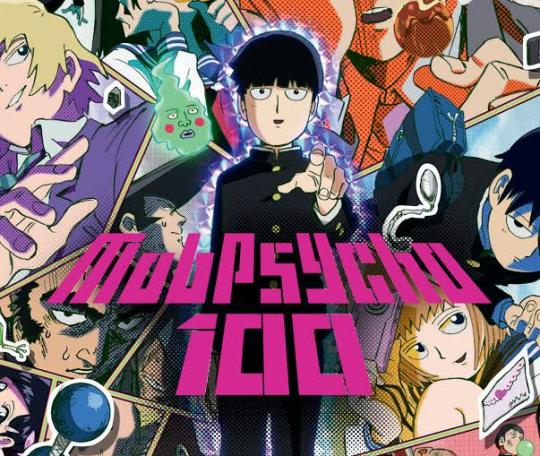
Belonging stories are often described as tough, difficult, distressing, but rarely are they... wholesome. Mob Psycho 100, despite the name, is a very welcome change to the formula of a beaten-down person fighting the world. Sure, the world has hardships and adversaries, but it also has support networks and allies.
Mob Psycho 100 is a story about a very rattled, timid boy named Mob who has been stricken with psychic powers, but the good people in his life help push Mob to become the best version of himself. The show has a lot of subversive themes, and much like Mob himself, sends a message that we should never judge a book by its cover.
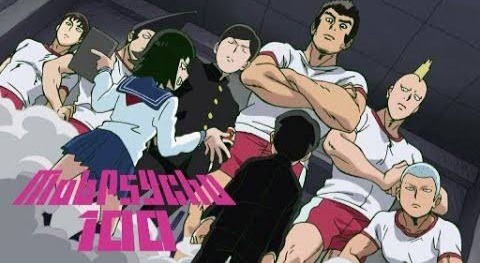
Mob's powers are strengthened by his own inner traumas and stress, and the anime will periodically update viewers on this mental state with a percentage out of 100. The higher the number, the closer Mob is to his breaking point, and when it reaches 100, Mob loses conciousness and a savage mindless version of himself fighting at full psychic force takes over. In most Shonen type anime, refining this form and pushing it to its full potential would be the end goal, but Mob is taught by his master to avoid using it. He can become a stronger person without losing control.
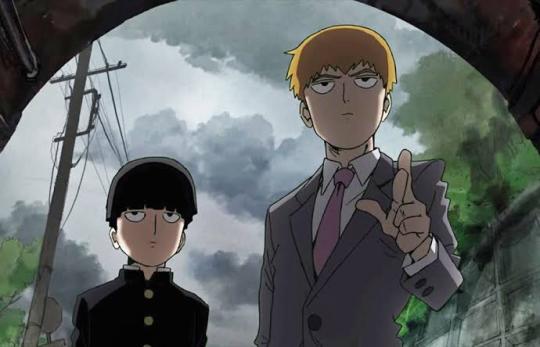
Reigen, the main supporting character is many people's favourite part of the series. We're introduced to him as a self righteous con artist who recruits Mob to benefit from having an actual Esper working for his exorcism business. But Reigen has a heart of gold and every action he makes is to grow Mob into an emotionally stronger person. Mob meets many other Psychics throughout the series that see the potential in Mob's power, asking him stop being nice and just go apeshit. But the first thing Reigen teaches Mob is to never use his powers against people. And he puts himself in the line of fire to uphold that value.
Mob Psycho 100 is an story about believing in yourself, and that if you look for help, it will be there, and you will grow stronger from it.
Anime: Miss Kobayashi's Dragon Maid
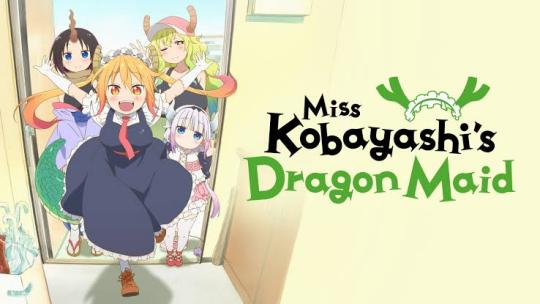
On the other end of the spectrum, what if you were a perfectly stable person, had a perfect grip on life and were always in control. But you lack company. That is the story of Miss Kobayashi's Dragon Maid. This anime sends a message from two different angles about how you can grow from a person with few/no flaws into a stronger form you never knew could exist if only you let others into your heart.
Kobayashi's Dragon Maid essentially has two main characters. Kobayashi was a business woman in her early 20s living alone and just generally enjoyed the solitary life. Tohru was a Dragon from another world who lived most of her life as an independent powerhouse, and mostly flew solo. When the two meet each other, they form a lasting bond that improves the both of them.
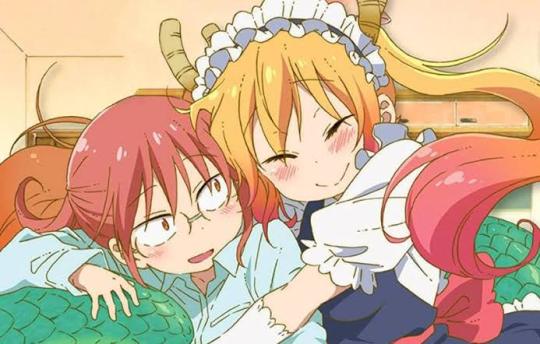
Although this anime seems mostly like a slice of life fanservice, and it is, the deeper story is about finding your place in the community, finding a home. Much of the anime focuses on Tohru, who has settled (mostly) into a human form adjusting to her voluntary role as a housemaid for Kobayashi. She comes from a world of magic and much of the way our world works is a learning process for her. Although she is a powerful magic user herself, Kobayashi tries to teach Tohru to be more humble and human. After all it is not the magic side of Tohru that Kobayashi enjoys, it is the social side, the emotional side, that endears the people around her. Tohru is brought down to Earth to become a more emotional, grounded person.
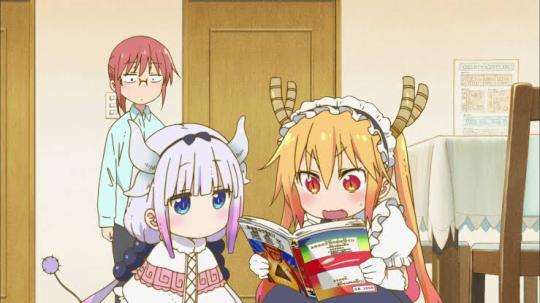
Kobayashi on the other hand, becomes more of an outgoing person as a result of caring for what eventually becomes two dragon girls. In showing the dragons how the world works, Kobayashi grows more socially confident and allows herself to express more of her quirkier side to her friends, and the dragons. The other dragon girl that moves in with her, Kanna, wishes to go to school, so Kobayashi is moved to become more motherly and socially involved in order to help Kanna achieve this.
Miss Kobayashi's Dragon Maid is a cute little story about finding where you belong, and who you belong with. You just have to put yourself out there and be nice.
Manga: Chainsaw Man
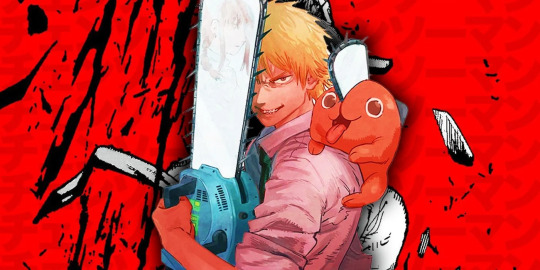
This is not a cute little story. Chainsaw Man is a very harsh, gruesome story about finding meaning in life. Main character Denji works in squalor as a devil hunter to make up the insurmountable debt his father left him. But when conditions force him into a situation where he is left in an even worse state, fate hands him a lifeline. After he becomes part devil himself, he is discovered by Makima, a high ranking devil hunter who works for the Public Safety Devil Hunters, and is offered a much cushier life in the big city. All it will cost him is his unwavering loyalty to Makima.
Given how rough Denji had it for most of his life, just being able to live a life of 3 meals a day, with a home and money is the ultimate dream. His allies tell him that he needs a dream, a goal, motivation, to give his life direction, but Denji believes that being allowed to live in relative freedom is the relative end goal. I say relative freedom because Makima is a cruel mistress, and her demands for allowing Denji to exist is that he become her dog.
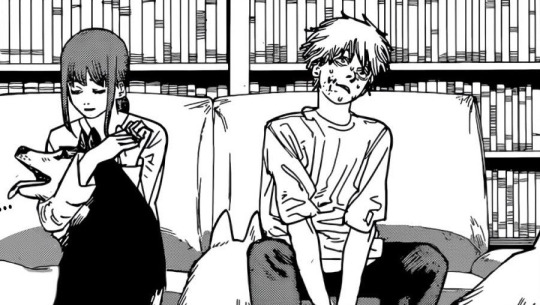
Chainsaw Man is not all doom and gloom however. The tone manages a unique balance of absurd, deadpan humour and senseless, non-nonsense violence. The action is a spectacle, but very straightforward, no pomp and circumstance, just chainsaw goes in, blood comes out. What sets this manga apart from other gory demon hunting stories I've read/watched is the growth of characters.
Where similar themed stories would start with a character who has a goal and they grow stronger to accomplish that goal, Chainsaw Man is about finding a goal to start with. Many of the characters, not just Denji, but Power and Aki too; their arc is finding a meaning in life. Yes they fight because they have been told to, but what if they found something to fight for?
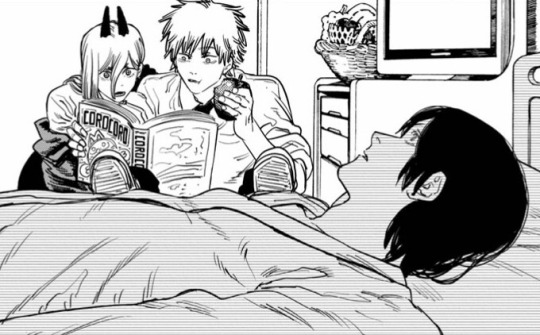
Chainsaw Man is about finding a reason to live. Instead of living in the moment because of who or what you belong to, decide what makes you want to keep living and live for that meaning.
#blogpost#blog#anime#anime recommendation#manga#manga recommendation#mob psycho 100#miss kobayashi's dragon maid#chainsaw man#belonging
22 notes
·
View notes
Text
Is It Really THAT Bad?
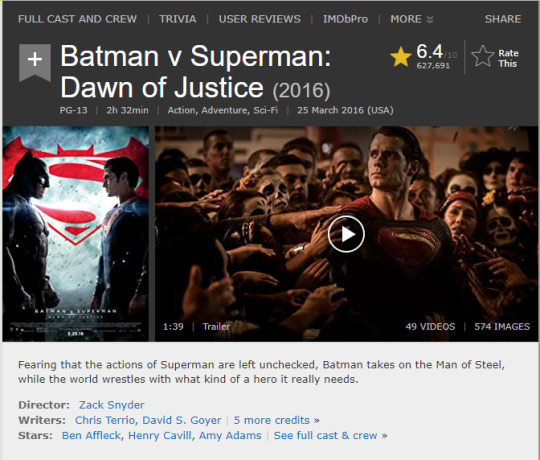
How many fucking times must I talk about this movie?
I feel like this movie doesn’t need an introduction. Everyone knows this film. Its reputation precedes it. It didn’t bomb and it’s not generally considered one of the worst films ever made (at least on the level of films like Robot Monster or The Cat in the Hat), but this movie is easily one of the most divisive films ever made. This film has generated enough arguments that, if we harnessed the energy of all the flame wars it has caused, we could probably power the entire world until the heat death of the universe.
With the impending release of Zach Snyder’s bloated redo of Justice League, I’ve decided to go back and ask myself of this film here… is it really that bad?
THE GOOD
Here comes the most uncontroversial opinion: the action scenes in this movie rock (or at least two of them do). The standouts are the titular showdown, which almost makes sitting through the rest of the movie worth it, and the epic warehouse fight Batman gets into, which is like something straight out of the Arkham games. It’s so good. And aside from that, a lot of the cinematography in the film is good. The film knows how to look good, though unfortunately it does end up being a lot of style with little substance.
youtube
On the subject of Batman, I think Ben Affleck is a great and inspired choice. I certainly think he’s worthy of standing alongside Batmans like Clooney and Keaton, easily embodying both the Dark Knight and Billionaire Playboy aspects fairly well, though the writing does not always handle him quite as well as it should (we’ll get to that soon enough). Henry Cavill, while still a rather dour Superman, is as good as ever as Superman, and Gal Gadot as Wonder Woman was a great choice here, especially since she didn’t have control so that she could insert anti-Arab racism, like some DCEU movies.
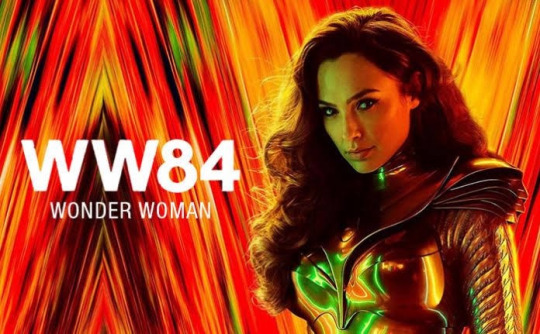
Perhaps one of the movies most impressive feats is how, in an uncharacteristic moment of brevity, it manages to condense the backstory of Batman into the prologue, getting it out of the way and not making us sit through yet another Batman origin film. This is literally the only thing the movie has over the MCU; where that franchise just has the character Spider-Man inexplicably in existence without even a hint of his origins, they just get Batman’s tragic backstory out of the way so we can see him beating the crap out of people. If more superhero movies want to take this route and just condense the backstory into an opening montage like this, I’d be down for it.
THE BAD
I really could just say “most of the movie” but that’s such a cop out. Let’s actually look at the problems. Let’s work our way up through the things from least problematic to most, shall we?
The best place to start is what Zach Snyder did to Jimmy Olsen.
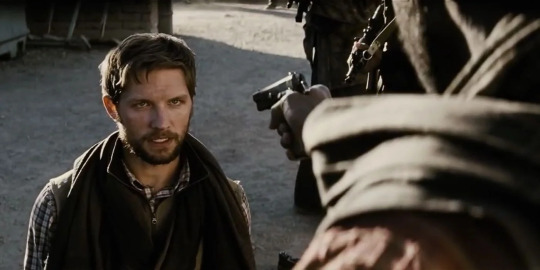
Jimmy Olsen is made into a CIA spook who is brutally killed early on, and yes, that was Jimmy Olsen. Snyder put him in to shock audiences with his senseless murder, and also because he felt the character had no place in his series. Does making Watchmen just turn people into joyless husks who like to horribly bastardize iconic characters? Jimmy Olsen is ultimately a small microcosm of the film, but he is the sum total of everything wring with the early DCEU. He is bleak, soulless, and shows a critical lack of understanding about the comics and why people enjoy them.
Now let’s move on to the more exciting problem to discuss: the villains. I don’t even think it’s worth wasting much time discussing what’s wrong with KGBeast. While it is kind of interesting they’d think to use the guy at all, the fact he never dons the costume and dies by the end of the film is unfathomably lame for a character named KGBeast.
Now, onto the main antagonist, and the most infamous part of the movie: Lex Luthor.
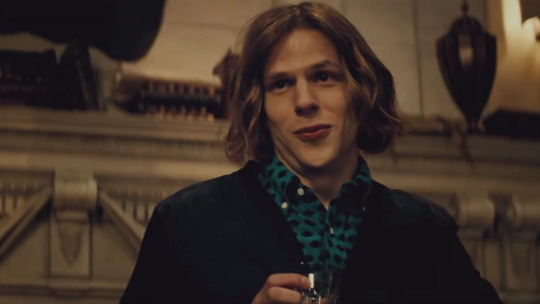
Lex Luthor is horribly, horribly miscast. Jesse Eisenberg is a great actor for sure, and he’s effective in movies like Now You See Me, The Social Network, and the Zombieland films. But here he is being asked to play one of the most diabolical cunning geniuses in comic book history, and rather than play him as such, he plays him like a cartoonish twit. This Lex is utterly unrecognizable as Superman’s greatest foe. Does anyone think Lex Luthor would send a jar of piss to someone as a joke before he blows them up? That’s more something the Joker would do on an off day. Lex is not cunning, not intimidating, and not diabolical in the slightest, and yet there are moments where Eisenberg’s acting chops shine through and Lex, for a moment, is almost engaging. Luthor really suffers the way Doctor Doom tends to in film adaptations: the filmmaker clearly doesn’t get why people like the villain, and decide to do some weird, unique take that will only cause to alienate fans.
But perhaps the worst of them all is Doomsday. Doomsday has exactly one claim to fame, and that’s killing Superman, so as soon as he shows up if you have even a passing awareness of the character you know how the movie is going to end, which robs the film of tension for its last battle. The fact he also appears with little buildup and doesn’t have any characterization doesn’t help; Doomsday is just the Big Gray CGI Blob that superhero movies try and pass off as a final boss for the heroes to fight. This has worked precisely once, in Iron Man. The Incredible Hulk and Venom did not make it work, and this film is nowhere close to being in the same ballpark as Venom.
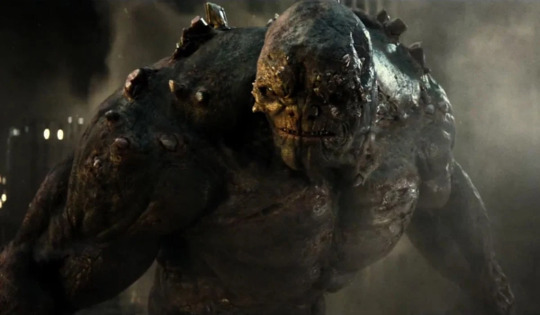
By and far the biggest problem, though, is the movie’s incredible length and its very existence in the franchise at this point in time. This is an epic superhero crossover in which two of the biggest comic book characters of all time fight and then team up… And it is the second movie in a franchise. While they do a good job of establishing Batman rather quickly, Wonder Woman comes out of nowhere. And then at the end, Superman ‘dies.’ We have had one single movie prior to this to make a connection to the guy, and yet here he is getting a temporary comic book death with no buildup whatsoever that we know is going to be reversed sooner than later because the movie telegraphs this to us.
Imagine if, instead of building up the character over the course of a decade and putting him in all sorts of different stories, the MCU went right from Iron Man to Endgame. You go from a simpler, character-driven piece to a massive crossover where a hero dies right away, and it doesn’t give anyone time to care. Tony Stark had multiple films worth of characterization under his belt before they threw him in a crossover, let alone killed him, but Snyder expects you to give a damn about a Superman who just started his career in the previous movie of a franchise.
And the ass-numbing length of the movie is no justification. Even before the director’s cut came out this film was a slog, and the director’s cut really does nothing to earn its existence. All it does is add more runtime to an already tedious and bloated film, leading to the same exact ending and fixing none of the overarching narrative problems of the thing. The problem with any director’s cut is that ultimately the movie is still going to be Dawn of Justice, it’s still going to lead to extremely rushed character decisions, and it’s still going to be a mess. You’d have to redo half of the film to make this into a worthwhile and coherent narrative that’s actually worthy of being an entry in a superhero franchise.
And to top it all off, the movie spends far too much time foreshadowing for its own good. People criticized The Mummy for shoehorning in way too many shared universe elements right off the bat, and if that movie was bad for it, so is this one. The cameos from all the members of the Justice League, while striking, could be excised from the plot with little to no impact, and the Knightmare sequence is just excessive and weird.
youtube
Is It Really THAT Bad?
The answer to this question has never been harder.
On the one hand, this film does have some merit. There is some good casting choices, good cinematography, good action… But then, on the other hand, the film is overly long, pretentious, has poor writing and dialogue, mishandles everyone aside from Superman, and is just incredibly unpleasant.
This film is in many ways the exact problem Christopher Nolan created with his Dark Knight trilogy. Nolan, by grounding the fanciful characters of comic books into a realistic setting, created a climate in which someone could suck any sort of joy or meaning out of comics. The success of his films meant that people would see dark, gritty realism as preferable to joyous, colorful escapism, and the negative effects of his films, however good you find them, are still felt today even as filmmakers are finally shaking off the grit. Dawn of Justice is the zenith of Nolan’s style of superhero film. There is nothing fun, joyful, or engaging to be found here; it is simply the characters you know and love forced into dark, miserable scenarios that ends in death and misery. Where’s the fun? Where’s the color? Where’s the wonder, the excitement, where is any of it? This film paints a bleak and miserable and hopeless picture of a world of superheroes. It really makes me think of this rather famous comic panel:
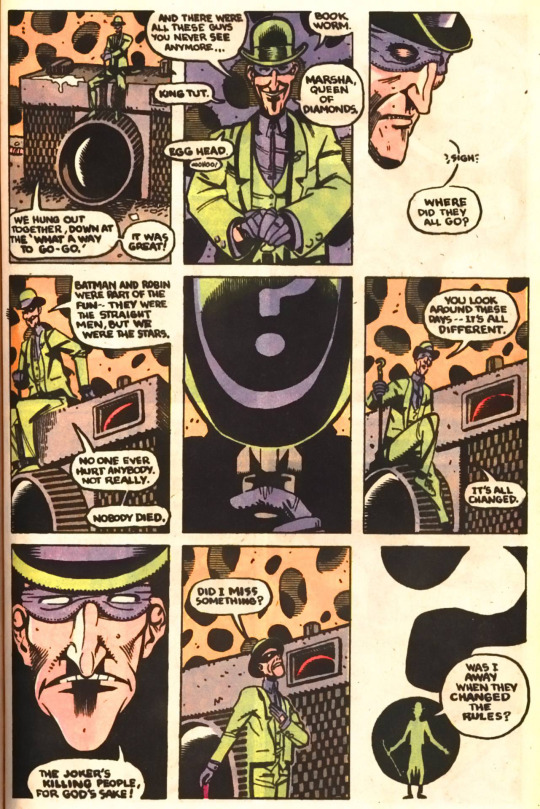
I absolutely hate this movie, but not because I think it’s bad. I hate it because it has enough good ideas where it should be the best thing ever, but it really isn’t. It’s a miserable slog of a film that does nothing to justify or earn its massive runtime whatsoever. It really does belong somewhere between 5 and 6 on IMDB, because I can almost see why people like it, but it just isn’t even remotely close to being how good its fan say it is. This is not a good superhero movie, and this is not how we should want superhero movies to be. There is a market for serious superhero fare of course, and there’s no reason that these films can’t engage with mature themes or anything, don’t get me wrong. But this is absolutely not the way to do it.
#Is it really that bad#IIRTB#Review#movie review#Batman v Superman#Dawn of Justice#Zach Snyder#Batman#Superman#DCEU
26 notes
·
View notes
Text
“Clarice” Liveblog: Episodes 5 & 6
Since these are extraordinarily late, I tried to keep them more concise/focused than before. I’m sorry for how long it’s taken me to (almost) catch up. And to the handful of you who’ve enjoyed these and encouraged me to do them: thank you!
Episode 5, “Get Right With God”
the music at the beginning of this episode might just be in the maintenance guy’s headphones(!) but it was still a…Choice.
there’s something so tragic about watching Clarice be unable to use her legs… :’(
this whole scenario feels like a twisted parallel universe version of the end of Hannibal.
glad to see Ardelia finally has her priorities straight and is going to fight for her best friend! let’s forget her Episode 4 subplot ever happened.
good: the warrior finding a weapon even in the direst of circumstances!
bad: those damn moths are back. at least this time they might be drug-induced.
“she worked Bill alone” no, she didn’t. not really. (Hannibal: I’m right here.)
stop trying to make Likable Paul happen, it’s never going to happen!!!
I HATE the “Reesey” nickname, y’all. HATE. IT.
plus, we know that her dad called her “Baby”?
her father’s appearance doubles down on the end-of-Hannibal vibes...Not Sure If Want.
wow, Clarice is being literally tortured? thanks, I hate it!!!
really doubt that Clarice’s Pinto used to belong to her father (who drives a truck in the books??)... weird flex.
and how would she even have gotten it? her mother would either have driven that car into the ground out of necessity or else have sold it for the money the Starlings needed so desperately.
Pintos also weren’t super high-quality cars and were definitely not built to last ~20 years.
Clarice already being able to chat with her father whenever she needs to really undermines the therapy Hannibal will eventually give her, but…I guess they’ve already accepted they’ll never make it that far?
“you’re trying to get in my head” yeah, and she’s doing it, too–’cause she learned from the best!
“you get an answer, I get an answer, Felker.” she’s Hannibal’s girl all right.
this episode’s had flashes of brilliance before diving back into…whatever tf watching one of your favorite characters of all time being tortured is.
I really wanted Ardelia to say that no, but Clarice was like a sister to her.
it took FIVE episodes to get some lamb imagery, but we’ve been looking at moths for the entire season?!
oof, Clarice voicing her own insecurities about her childhood abandonment and using them to twist Felker’s arm...painful but smart.
HANNAH!!!
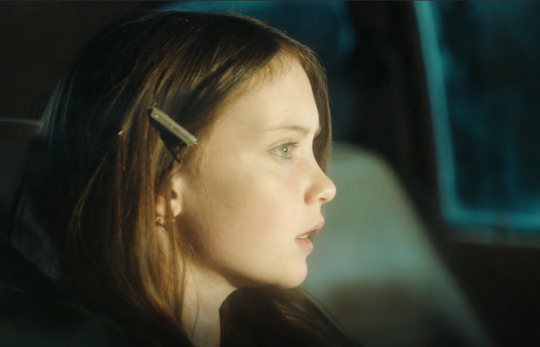
I would die 4 baby Clarice
after all that, Clarice is going to apologize to Ardelia about last week? this episode SUCKS.
Good: Clarice playing mind games with Felker like Hannibal did to her; Ardelia going to bat for her bestie, lamb flashbacks, baby Clarice, and HANNAH!
Bad: So much. Clarice being medically tortured multiple times, moth hallucinations, the several-years-premature (imo) Daddy-as-Guardian-Angel plot device, “Reesey”...did I mention Clarice getting repeatedly tortured?!
Ugly: Krendler backstory + making out with his wife. Ew.
Wow, this episode was a hot mess, and I kind of hated it. I loved Clarice’s really Hannibalesque approach to Felker, and I’m so thrilled that Hannah got mentioned at all (tho...did they need to be so heavy-handed with the helmet and gun and everything?) Also nice to see Ardelia behaving much more in-character. That said, it was sickening and imo totally unnecessary to further traumatize Clarice the way they did. To make her almost helpless.
Clarice, and by extension Rebecca Breeds (who is fantastic and deserves better), has been given very little range so far. She’s frequently been shown as miserable, afraid, desperate, traumatized, angry, resentful, but I also want to see her joyful, laughing, silly, relaxed...something else that will give her depth. Her life wasn’t miserable 24/7, 365. It was just unfulfilling. We got glimpses of this in the first two episodes. PLEASE bring it back!
And rn I’m questioning how Clarice’s career can possibly drag on for another six years after this. Her apparent PTSD is already interfering with her job performance as it is--this experience is only going to make it worse. Her “body count” in Hannibal was around five, iirc, and that was enough to slap her with the “Death Angel” moniker. In the show at least four people have died in close proximity to Clarice in the space of like...a week. How does she come back from that, even as the savior of Catherine Martin? It’s a PR nightmare for obth Clarice and the FBI.
They’ve also sort of forgotten that the Martins existed while continuing to flesh out Krendler’s (?!) character? It’s weird.
I almost don’t even want to watch Episode 6 after that. But here goes...
Episode 6, “How Does It Feel to Be So Beautiful?”
the freaking MOTHS again, I hate them!
frankly, yeah, Clarice should be on leave.
Clarice’s nondescript monochrome suits and constant ponytail are just so boring. in the book she’s described as never having to put effort into making her hair look good--so why is it always pulled back in this show?
I’m not sure it’s very in-character for Clarice, at this point in her career, to go over her boss’s head to get out of admin leave (one she really needs to take tbh) even for the sake of solving a case
lol what the actual hell @ AG Martin guilt-tripping Clarice, who was very recently tortured and almost died, for not calling Catherine back? Clarice is not Catherine’s therapist!

THIS is what my Vogue-reading heroine with burgeoning great taste wears for a night out? so disappointing.
never in my life did I think I’d be sitting through Krendler’s personal drama in a show ABOUT CLARICE STARLING.
her costume sucks and her hairstyle’s from years in the future, but dang does Clarice look gorgeous.
and I love thinking of her getting a taste of the luxury she’ll enjoy with Hannibal. :)
you know what? I think I was actually fine with them forgetting that the Martins were in this show.
whyyy is Krendler being made so sympathetic?!
now Catherine Martin “loved to sew” just like Frederica Bimmel? hmm. (tbf, maybe this is in the novel, and I’ve just forgotten.)
her gift for Clarice is sweet, though.
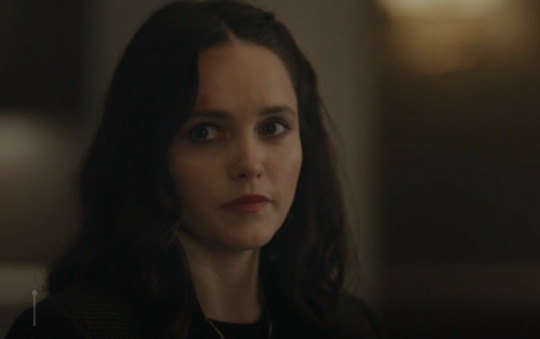
so beautiful, indeed
Christ on a cracker, that confrontation between the Martins was painful to watch (not a criticism). this show’s AG and her daughter are very much two of a kind in terms of emotional manipulation.

I stan one (1) doofus
now either Catherine’s gaslighting Clarice...or Clarice’s trauma (over BILL! again with this!) is so pervasive that it’s twisted her memories. either way, I hate it.
so Krendler’s lawyer is dirty and that’s why he’ll (probably) turn against Clarice? but WHY? why can’t Krendler just suck?
Good: Clarice looking gorgeous, Ardelia continuing to fight for Clarice, female characters in positions of authority everywhere
Bad: Clarice’s underwhelming costumes, Clarice’s primary/worst trauma apparently STILL being Buffalo Bill & having Clarice break down crying again (and NOT over what happened last week, which would tbh make a lot more sense).
Sad: Shaan’s backstory about his wife, everything involving Catherine
Ugly: Krendler subplot. Ugh.
I just don’t know how I feel about this installment. Wish I cared more about the overarching conspiracy plot, but I’m really only here for Clarice and Ardelia. And while no show can stand on the shoulders of a single character, for a show about Clarice, there seems to be quite a bit of screentime devoted to her bosses, Martin and Krendler, and even to her team members. And all without Clarice herself getting much character development. They don’t seem to be exploring much of her character other than her traumatic backstories, and I’m no longer very hopeful that she’ll be much more fleshed out in the last four episodes, either. It’s a bummer. I really think Rebecca could shine like Jodie did if she were given a chance.
Most of the scenes with the Martins were visceral and felt so real that it was hard to watch. That said...the AG Martin/Catherine content all strikes me as being somewhat detached from the rest of the show, as if the writers are making it up as they go along with no real end goal in mind.
Man...these two were rough going. Very little humor or warmth and absolutely no joy. Of course the source material is dark, so a somewhat dark crime drama is to be expected, but I really think the show needs a slightly less intense, bleak and (dare I say it?) unpleasant episode. But they writers have really dug themselves into a hole by zeroing in on Clarice’s PTSD. And unlike in Hannibal, there’s no love interest with whom she (and by extension, the audience) can flee her misery and pain.
I'm cautiously optimistic about the rest of the season. A lot of the ingredients are there, and despite my many criticisms, it’s been great to spend time with a character I love. Fingers crossed that they finish strong!
#Clarice Starling#cbs clarice#clarice#rebecca breeds#spoiler warning#bc I know a few of you haven't quite caught up either#long post for ts#media [cbs show]#actor [rebecca breeds]#char [clarice starling]#char [the night watchman]#char [paul krendler]#char [ardelia mapp]
17 notes
·
View notes
Note
Hey! I just started reading your Origins of Pixies fic! Is it okay if you could brief me on all the species in your canon, like the wisps, to the aluxo'ob, to the brownies and so forth. Mr. Thimble mentioned many many species in the first chapter, but I felt my head spin a bit keeping up with what made them distinctive and your own biology to them.
I can! Thanks for reading (and for visiting).
.
CLASSES
There are four overarching classes of Fae, and two classes belong under each alignment. These are the Seelie Court (Fairies and Pixies) and the Unseelie Court (Anti-Fairies and Refracts).
Depending on your interest level and how deep you want to go, you can read more about these four classes in these big worldbuilding posts.
Fairies | Pixies | Anti-Fairies | Refracts
Each of these four classes has a distinct culture. If you understand these four groups, nothing else about subspecies matters. It looks complicated on the surface, but these four groups are what it boils down to in the end.
Here is the TL;DR of each class’s culture:
Fairies - I designed Fairy culture to mimic independent insects such as butterflies and dragonflies; Fairies have friends and families, but don’t have big community vibes. They are obsessed with rules. Brawn over brain. Paranoid and usually independent. Will actually fight you. Murder is legal in Fairy society and they’re the only race that will literally kill you without holding back. They’re the kind of society that shows violence on kids’ shows.
.
Pixies - Pixie society is similar to eusocial insects (wasps, bees, ants). The queen (or in this case, Head Pixie) is the absolute ruler and everyone below exists to serve and please him. Pixies are hard-working and like to keep things organized, but they’re not afraid to break the rules (or even Da Rules). Pixies Inc. is a business populated entirely by members of one big extended family, so some of their workplace behavior might seem immature (pushing each other in the halls and tattling for example. It’s like a family reunion at all times. Lots of rivalry and sibling jealousy.
.
Anti-Fairies - Culture based on bats, obviously. They’re colony-oriented and their culture revolves around elegance, feasts, and art. Super social people who are big on community and conflict resolution. They rarely fight amongst each other, and you’ll mostly feel “us vs. them” vibes (them being the Fairies, of course). Brain over brawn.
.
Refracts - Culture based on birds (social migrating birds specifically). Obsessed with goodness and stereotyped as pure angels (the opposite of Anti-Fairies). Extremely proud, religious, and self-righteous. These guys make their official debut in Chapter 17, “The Blessed.” Don’t forget about them, because they come back several times.
.
SUBSPECIES
The underlying reason all these subspecies exist is kind of a meta joke used to subtly poke fun at Fairies for getting hung up on insignificant interspecies differences. Fairies tend to fight amongst each other while Anti-Fairies get along, so you’ll notice that H.P. (who was raised in Fairy culture) will get hung up on subspecies and stereotypes more than Anti-Cosmo, who is more accepting and only points out species as a descriptive detail.
Species rarely matters except these notes:
Common fairies are “pure” and are held in high esteem. Cosmo, Wanda, and Jorgen are common fairies.
.
Cherubs are Cupid’s species (Cupid is not a god in my FOP universe, but his family was blessed by gods long ago). Cupid’s family, the Eros Family, are the most powerful of all Fae (magically and politically).
.
Brownies are looked down upon (They are viewed as “natural-born servants” and creeps who sneak into your house). Brownies have large noses and venomous saliva. Cosmo has a brownie grandparent.
.
Will o’ the wisps (or simply “wisps”) are beautiful temptresses who were cast out of Fairy society. They have butterfly wings (if you know Goldie Goldenglow from the Season 8 episode “Love Triangle,” that’s what they look like). Notably, the first wisp was Ilisa Maddington. H.P. secretly looks up to Ilisa because she had a gene mutation just like him. He considers himself a broken and ugly mutation and is jealous that the public adored Ilisa’s beauty but rejected him.
.
Since you specifically asked about aluxo’ob and there’s an important alux character who appears later in the ‘fic, just note that they’re invisible unless you look directly at them and they can hear you when you talk about them, no matter where they are.
.
If you want to go deep and read about all subspecies and the Fairy caste system / social ladder, click HERE
That’s basically the breakdown. My advice is, you don’t need to keep track of individual species traits beyond what I listed above, because subspecies mostly exist to show Fairy culture’s obsession with rules and categorization. They like putting everything in boxes, including themselves.
#trookay#FAIRIES!#ridwriting#asks#Origin of the Pixies#One of these days I should probably revise Origin but I'll save that goal for when the 'fic is done
10 notes
·
View notes
Text
Vibe of the week 23/08
The HWIC is in.
Gird your loins, mind the gap, fasten your seatbelts and pour yourself a drank. There are no emergency exits at this time. We do not apologize.
The Oracle this week is the Earth Power, and the Tarot is the Wizard’s Tarot. Sidenote about that deck--it has, quite literally, been glued to my side for a few weeks now. That deck is being real good to me, despite my initial hatred for it. I’m sorry boo. We cool now.
Sidenote sidenote: My dudes, Leo season has got me all kinds of fucked up. My Leos. They are in pain. Unprecedented pain, and they’re navigating unfamiliar territory and I just...I just want to hold their hands. Tell them it’ll be okay. I got an inkling of it when I did that spontaneous reading for Bill’s birthday and I pulled cards that kind of just had me going whoa now, hold on a goddamn second. I wanted to re-shuffle and pull again and specify that uh, this is Leo we’re talking about but that’s not really how Tarot works. They show me truth. That was just...that was just a preview. A small one. Ali’s Tarot on YouTube is one of my favourites (I find her weirdly ASMR? Also, dat riffle shuffle. Sick.) and I’ve been watching my own Libra readings along with the Leo ones because something is just...something is not right with Leo. The universe is beating the shit out of my Leos. This one, in particular, hurt me for like the entire fucking week. Bill, my dude, wherever you are--just like, get drunk or something. Call Landon. Go see Landon. Just do something before that Tower crumbles around you, in whatever way it is referring to.
The Oracle card this week is Amazonia:
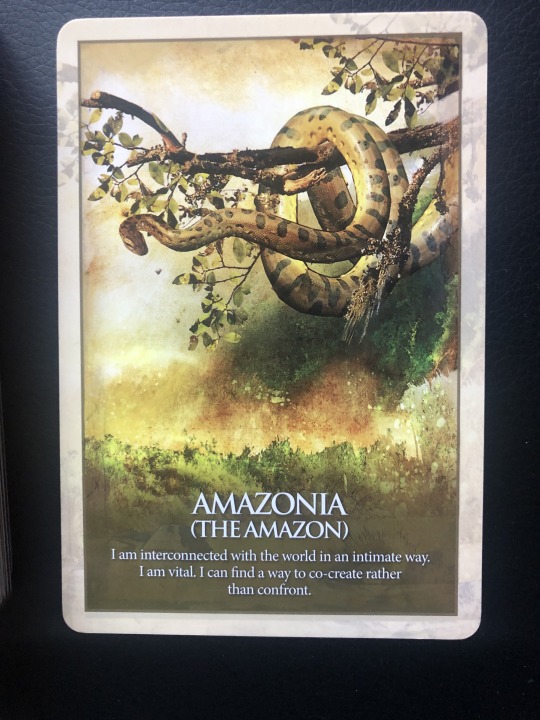
The affirmation: I am interconnected with the world in an intimate way. I am vital. I can find a way to co-create rather than confront.
Words to meditate on: self-value, harmony, cooperation balance.
There is no such thing as consequence in this world, every single one of us is interconnected both with each other and with the universe. We have value. We have place being here--you hear me? You belong here. You have purpose here. You have value to add to this life, this world, this relationship--everywhere you go, you bring value and light.
And with that light, shine it inwards for guidance and for wisdom. Don’t ever raise your voice--improve your argument. Do not stop fighting, but fight differently. Fight smarter. Fight in a way that you are the only one who knows that this is a fight.
Find better ways. Whatever it is that is opposing you, find better ways.
The Tarot:
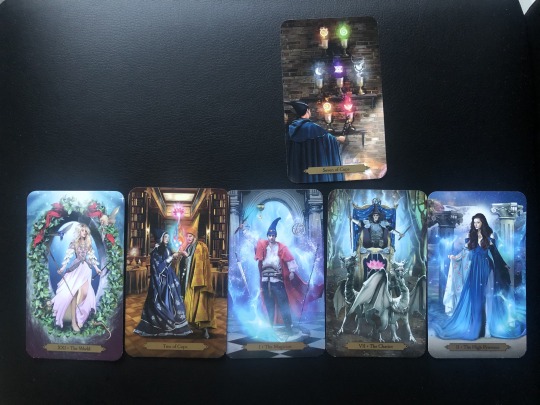
HAHAHA /FUCK
It’s fine. It’s all fine. We can do this.
1) The World (Major)
2) Two of Cups
3) The Magician (Major)
4) The Chariot (Major)
5) The High Priestess (Major)
Overarching theme: Seven of Cups.
That’s four Major Arcana in a six card spread.
That is more than half.
I SEE YOU, LEO, YOU OVERACHIEVING SON OF A---
If you were waiting for a sign from the universe--that’s it. That’s your sign. Four fucking signs, actually. I feel like you doubted all the ones before so now the universe is like “fucking really? Get it through your thick fucking skull--” and just got all ornery about it.
Let’s unpack this.
The only Suit that shows up is Cups, so this is heart-based.
Overarching theme as the Seven of Cups--escapism. The Seven of Cups is dat bitch who is too drunk in the club, drunk and sloppy to the point where you’re not even annoyed--because if she’s at that point, then you know homegirl is dealing with some shit. And you wish her the best. Maybe step on the toilet paper stuck on her heel as she exits the bathroom, so that at least she can have a small win that night.
This card is euphoria but in the bad sense. You need the escape. You look for it anywhere. You will accept it from everywhere. There’s a delaying or denial of reality here, a resistance to responsibility--but like, in 2020? Honestly who can fucking blame us. Yes I will take my escapeism, thank you very much. The Devil I know can kill me any time he likes.
It might fucking hurt less than the entire BULLSHIT that is this year.
The World--This is the last card in the Major Arcana, before the Fool is reborn and the cycle starts again. There is completion, here. But where as Death steals from us something that we do not wish to let go of, The World ends it gracefully, naturally, in a way that brings us peace, satisfaction. In a way that makes us feel stronger, and more ready to take on the next challenges. The World speaks of retreat, of quiet and well earned rest. I don’t feel, in this reading, that this symbolizes the end of a cycle--but rather, the very exuberant birth of another one. Something happened here, you realized something. Something became clearer to you, something became more concrete, something got through to you in the way you needed to receive it, and like a fucking champ you welcomed it with open arms. And off you go on this journey.
The Two of Cups--ah, young love. This could mean literal love, or it could mean that incredible feeling that is instigated by something else. Something is bringing you joy here, is giving you a bit of a thrill--whether it’s school, a new friend, a new job, an adventure, you are looking forward to something and you’re all cute and starry-eyed about it. The Magician tells me it’s something you have wanted for awhile.
Actually, you know what? I can’t read the next cards independently, they all go together.
You are just....honey, you feelin’ yourself.
You hoped for something, worked very hard at it, manifested it, thought about it a lot, and in doing that you kind of...brought it to you. Attracted it to you. And yes it’s real, and yes it’s yours. This one is for you. And it happened a little quicker than you thought possible, maybe even a little easier (did you really want it that bad? There’s no way you could have wanted it more than the 8000 other people who didn’t get it. Why did you get it? You don’t deserve this. Shut up. You hear me? Shut those thoughts the fuck up. This is yours.) And what’s even better is this is just--this is not done. That Chariot, he’s moving quickly kid and he’s heading right for you and beyond. Hop on, and hold on. The High Priestess has you channeling the highest version of yourself--the one who knows all, sees all.
You ever get approached by a guy in a bar or a club, one that you just know is scum and like, so far beneath you? You ever just calmly stare at him, knowing you could crush him and everything he loves, without even breaking a sweat? And enjoy it? Because crushing this dude might knock him down a few pegs, which is a win for humanity everywhere? That’s your High Priestess. She is Queen B, man. You don’t want to fuck with her, and when she shows up in a spread like this? She’s got you. She’s got you so hard. Her and all of her friends are standing behind you, ready to fuck that guy’s shit up.
Your intuition is strong right now. Things are moving, you feel like they’re moving in a good way, but it’s so fast and so random and so spontaneous that you kind of just...can’t believe it. Remember the overarching energy of escapism--go along for the ride, but don’t stay on it. Let this move you forward, but then be ready to hop off and put in the good work. An easy high is addictive, and it’s one you want to stay on--but don’t. It will lead you to stagnation, to a denial of reality. You are here because hard work was done. You get to enjoy it now--you get to rest, but more hard work will need to be done to stay on this path.
Remember the Oracle, about how we’re interconnected? This is the universe proving it. It’s saying that it’s got you. The bit about fighting a different fight, fighting smarter? Channel your High Priestess. She understands it at a level you cannot--she is with you, she’s not a warning here but a guide--be open to it, be humble, and know that there is more. There is more that you don’t understand. There is more that you cannot see. Know that, and bring her with you--ad she will show you a different way. A better way.
7 notes
·
View notes
Text
The Mandalorian S1 Review
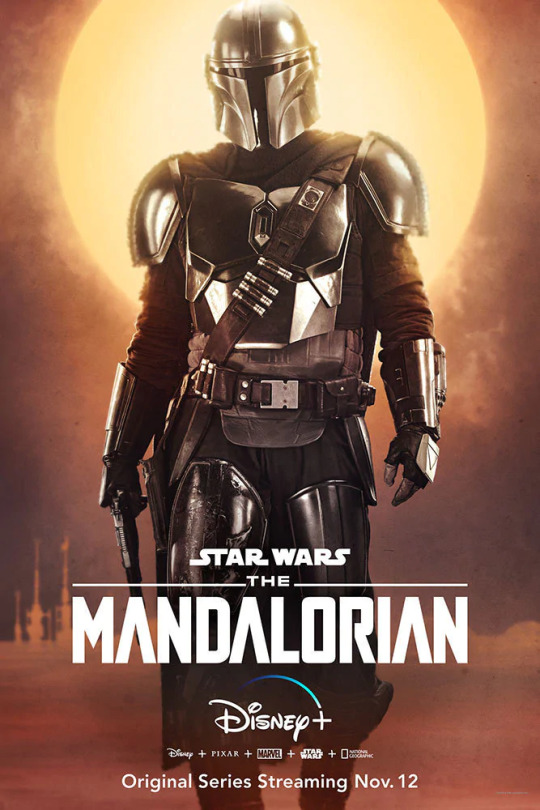
Warning Spoilers Ahead:
I admit I had my doubts when I first heard about the series, given my opinion of the Disney Star Wars universe has never been particularly high. I thought it might go the way of the sequel trilogy (my thoughts on the last one).
However, to give Jon Favreau credit, he actually does a pretty decent job. The show is basically a Wild West-version of Star Wars that takes place on the frontier with bounty hunters, homesteaders, mercenaries, roving gangs of bandits and corrupt officials.
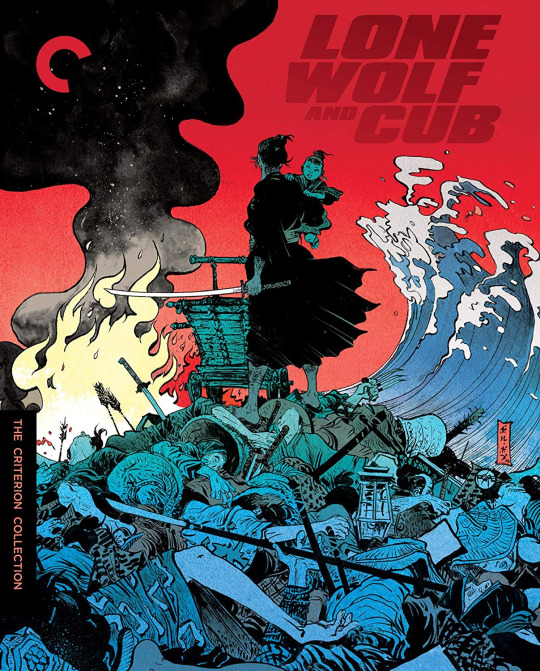
I can’t go into it without mentioning the story it’s partially based on the manga, Lone Wolf and Cub. The story follows a ronin in Tokugawa Japan who travels as an assassin for hire with his son (an infant at the beginning) after being framed and betrayed by a powerful Imperial official. He cares for his son while being on the run as the Imperial government declares them both outlaws, and puts bounties on their heads.
This show gets right what the movies in the sequel trilogy didn’t. For starters, this show avoids exposition and instead relies more heavily on visual storytelling, slow pacing and info revealed offhand through brief bits of dialogue. The show does an excellent job of visual storytelling as everything about this character is shown through actions, body language and a little dialogue. The first half of the first episode tells much of what the viewer needs to know about him.
Mando is introduced by coming into a bar, and killing a bunch of men harassing some alien. In that moment he shows that he is a skilled gunslinger and fighter. The alien initially thanks him, only for it to be revealed that the only reason Mando helped him was not out of a feeling of justice or simply wanting to help someone out, but because he came to capture him for the bounty on his head. Mando isn’t some white knight, but a mercenary who acts generally out of self-interest. We learn that Mando doesn’t like droids when he refuses a ride on a transport from one, and instead preferring the more beat up transport. He is also a man of few words, rebuffing attempts by the alien to engage in conversation, and he speaks only when he feels he needs to.
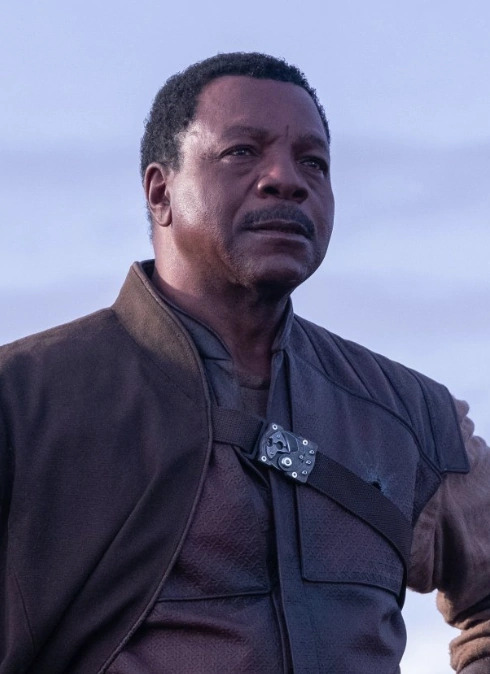
He gets his jobs from Greef Karga, a disgraced former magistrate (who likely lost his position as a magistrate for shady dealings) who heads the bounty hunters guild, and like Mando and the other guild members is generally an amoral, self-interested individual who looks out for himself.
However, we also see that Mando isn’t a completely selfish, amoral rogue as we see him adhere to the code of his Mandalorian culture (”This is the way”), and give some of his bounty to the foundlings (orphans). We also see flashbacks of him as a child, undoubtedly during the Clone Wars, as Super battle droids attack his town.
We don’t need him to outright state his motives for saving some strange child given we see he always save a piece of his beskar iron payment for the Mandalorian foundlings, showing he has a soft spot for orphans given he himself was one, compounded with the child saving his life. We know that Mando hates droids, but he doesn’t need to tell us why as we see that in a flashback of his town being massacred by Separatist battle droids. However, we also see him grow past that as he is stricken when IG-11 decides to sacrifice himself to help the rest of the group.
The start of the protagonist's journey comes when he receives a job that should give him the biggest payment of his career up to that point. He is contracted by an old Imperial official to capture someone in exchange for a large payment in beskar iron, which he knows could be used to make the full Mandalorian armor he wants.
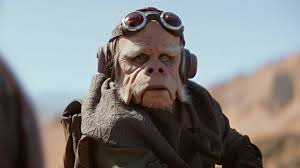
It takes him to a planet where he meets Kuiil, a moisture farmer who helps out Mando many times. He speaks matter-of-factly, often ending his sentences with his go-to phrase “I have spoken.” Being an Ugnaught, like other members of his race, he was enslaved by the Empire, but he managed to buy his freedom. He likely did so through his skills as a mechanic, as he managed to help Mando rebuild his ship and repair and reprogram IG-11. He is very proud, but not haughty and willing to go out of his way to help out a complete stranger at no benefit to himself such as helping Mando get back the parts for his ship and helping to repair it. He even goes with Mando far away from home on a dangerous mission. It’s also his reprogramming of IG-11 that ultimately ends up saving our protagonist and his party in the end.
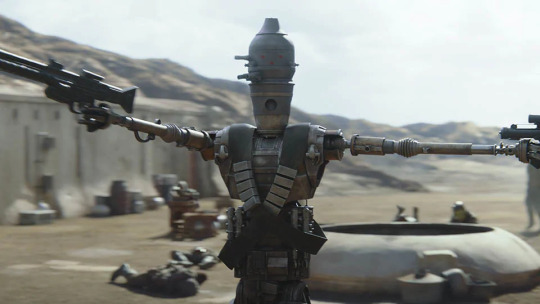
To get to the prize, Mando has to fight his way through a compound with armed guards with the unexpected help of IG-11, an assassin droid. The entire sequence is a Western-style shootout which is well-done, and Mando demonstrates his skills and smarts such as using the heavy repeating blaster to shoot down the blast door. He goes in, and is surprised to find his target is actually an infant of Yoda’s species.
His relationship with Baby Yoda starts off with him shooting the droid, because it was about to shoot the baby. He does defend the baby, but he does it at the beginning simply out of self-interest, ie he is getting a huge payload for this job and he needs the child alive in order to get it. He even recklessly puts the child in danger by taking the baby with him when going to face the Mudhorn, simply because he doesn’t want to keeps his eyes off his prize. However, in that moment the child demonstrates that he can use the Force, lifting the Mudhorn off the ground, saving Mando’s life and giving him the opportunity he needs to slay it. After that, one can see him warm up to Baby Yoda. One can see it when he tells the stormtroopers to “take it easy” when lugging the cradle, and he even uncharacteristically asks about the fate of the child when he delivers it to the Imperials.
Even after he gets his payment and a new Mandalorian cuirass, you can tell the child is on his mind. Mando is about to leave for his next job, and try to get his mind off him, only to find the top of the handle for the ship removed by the baby earlier. He pauses, and then shuts off the ship. He doesn’t need to say anything, we know he is genuinely concerned for the baby, and later breaks into the Imperial compound and rescues him. However, all the other bounty hunters who tried and failed to capture the child before, go out to stop him. Even Greef who was friendly towards Mando as long as he was making himself useful to the Guild (and by extension, Greef himself), instantly turns on him. He manages to escape thanks to the interventions of the rest of the Mandalorians. Mando finds himself having to leave town being pursued not just by Imperials but by the Bounty Hunters Guild with bounty hunters on his tail. The episode is called “The Sin,” which refers to his act of rescuing the child. While any person can admit that he did the right thing, he broke the code of the Bounty Hunters Guild, and that action ultimately is what turns him into a fugitive. That none of the people he killed as a bounty hunter ever got him into trouble with the law, but doing the opposite and rescuing an innocent does, shows the skewed ethics and morality that govern the world he inhabits.
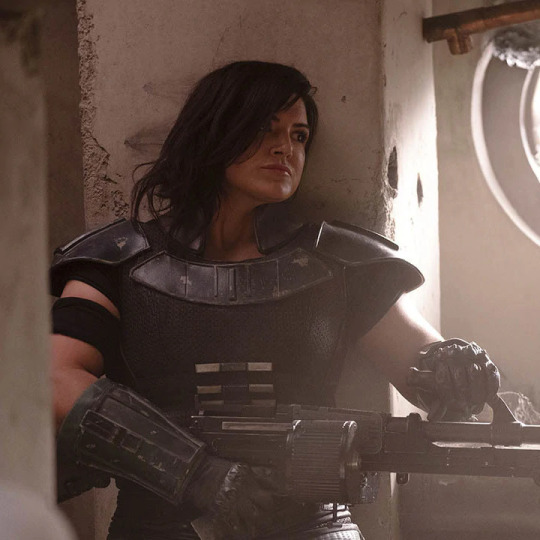
He flies to a backwoods planet in “Sanctuary,” where as the title suggests, he is hoping the planet’s isolation would give him the perfect hiding spot until he comes across a former Rebel shock trooper, Cara Dune. Cara Dune is shown to be a skilled fighter by being able to go toe-to-toe with Mando when we first meet her, and has the viewer easily believe that she is a former commando. Now that the war is largely over, finds herself out of work and without anything in the way of a home or purpose, not that different from Mando’s situation when they first meet.
He is about to leave until in a plot straight from a classic spaghetti Western, a poor farming community approaches the gunslinger for help against outlaws. He initially refuses given the poor payment, but only accepts after he learns of the community’s isolation, thinking it would be the perfect hiding spot. You see him work with the Cara to help the villagers defend themselves, and after the bandits had been routed, he decides to leave the child there, thinking he will be safe and happy there. He even refuses an offer to stay, saying he doesn’t belong there (another trope straight from a Western a la The Searchers). However, in a seemingly happy ending to this episode, cold, dark reality inserts itself in the form of a bounty hunter appearing and nearly killing the child were it not for the intervention of Cara. He is then again forced to leave with the uncomfortable knowledge that they may never be safe from others coming looking for them. In this episode, you actually see him develop as a character, putting the child’s interests above his own. He doesn’t agree to help the villagers until he learns their village is a place where he could hide the baby, and potentially have the child live in peace.
Among the episodes, 5 and 6 (”The Gunslinger” and “The Prisoner”) are easily the weakest, as well as both being the only two episodes written by writers other than Favreau. The former has him working with a neophyte bounty hunter, Toro Calican, to capture a wanted mercenary and assassin, Fennec Shand. The latter has him help an old cohort, Ran, free a prisoner from a New Republic prison ship. Both plots are just criminals and wanna-be bounty hunters allying with him just to screw him over in the end, and neither episode really contributes to the overarching narrative. At least “Sanctuary” had some heart in it, and we got to be introduced to interesting new characters that would go on to play a larger role in the story arc, as well as show some character development for the protagonist.
It picks up again with the final two episodes, “The Reckoning” and “The Redemption,” as Mando returns home per Greef Karga’s invitation ostensibly to help them get rid of the Imperial presence. Of course, after Baby Yoda heals Greef’s mortal wound he has a change of heart. He reveals the whole thing was a setup (I know, big surprise there at this point), and he decides to help Mando. They end up having to fight a new enemy: Moff Gideon. Through dialogue from other characters and his own actions such as killing his own men, Gideon is revealed to be a largely cold, ruthless figure who oversaw the wiping out of the Mandalorians.
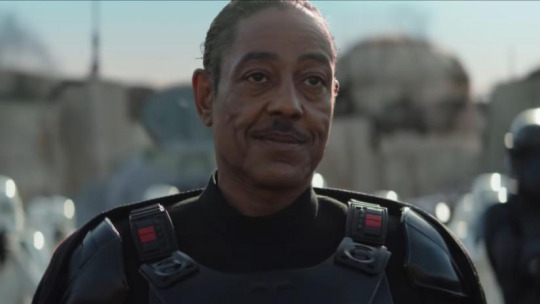
It ends in a shootout, and we get to learn our protagonist’s name and see the face behind the helmet for the first time. In his final fight, he manages to take down Gideon in a TIE fighter after having earned his jetpack. He then refuses an offer to stay by Greef, and leaves the planet off to new adventures. However, as Jawas are scrapping the TIE fighter for parts, Gideon cuts his way out with the Darksaber, the lightsaber of the leader of the Mandalorians, suggesting that his part in the story isn’t done.
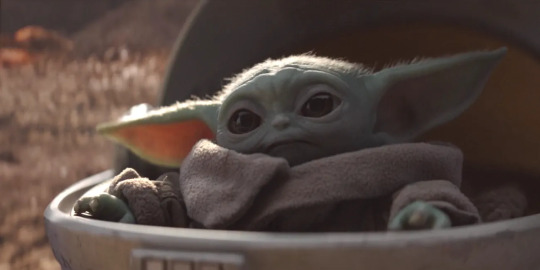
As for the child dubbed “Baby Yoda,” he has no name. Being an infant, he can’t have much in the way of personality other than being precocious, and he does seem to genuinely care for Mando. The child is Force-sensitive, and completely capable of using the Force as shown by lifting the Mudhorn, healing Greef and redirecting the blast from a flame projector. However, he is still just a baby, only using his Force powers randomly rather than consistently, and as such, can’t really be relied upon. Nothing demonstrates this more than in the final episode where under fire by a TIE fighter, Greef says “Baby, do the magic hand thing,” only for the child to respond by simply waving his hand. This works as it has the mystical part of the story, the Force, used in a constrained manner, at certain moments without overwhelming the plot.
As a result, the battles are still largely won through Mando’s fighting skills and smarts. The action sequences are good with plenty of Western-style shootouts such as when Mando attacks the compound, when he leaves town against other bounty hunters and in the final episode against Imperials. The shootouts also serve a role in the plot in serving as markers for the main character’s growth. The first shootout has him using a heavy repeating blaster and working with IG-11 to take out the fighters defending the child. The second shootout has him going up against bounty hunters wanting the child in hopes of the reward very much like he was at the beginning with even Greef referring to the child as “the bounty,” and he is saved by his own family, the Mandalorians. The last shootout has him again using a heavy repeating blaster and working with IG-11 like in the first shootout, but the roles are reversed as now his party is the one defending the child with the droid that originally tried to kill the child instead rescuing him.
The Mandalorian is for the most part a good show, and a breath of fresh air for the new Star Wars universe. The action scenes are excellent, but any show/movie good or bad can do that. What really makes the show work is the storytelling, and how it follows the main character on his journey, both externally and internally, going from amoral mercenary to hero.
Hopefully, Season 2 continues along that path and we get to see more of the character’s growth as well as more fight sequences as this is the way.
20 notes
·
View notes
Text
(REVIEW) Tongues by Taylor Le Melle, Rehana Zaman and Those Institutions Should Belong to Us, by Christopher Kirubi

In this review, Rhian Williams takes a look at Tongues, a dazzling zine edited by Taylor Le Melle and Rehana Zaman (PSS, 2018), with* Christopher Kirubi’s pamphlet ‘Those Institutions Should Belong to Us’ (PSS).
*I [Rhian] use ‘with’ here in homage to Fred Moten’s use of that preposition in all that beauty (2019) to ‘denote accompaniment[]’. This pamphlet was interleaved in the review copy of Tongues that I received from PSS.
> Onions, lemons, chilli peppers, fractals, hands, patterns, palms pressing, tears, avocados, pomegranate, mouths, finger clicking, deserts. Screenshots, flyers, placards, transcripts, textures, temporalities. Tongues is an urgent gathering in, a zine-type publication that works as a space where Black and Brown women (bringing both their intersections and the tension of distinction) enact memorial, exchange, jouissance, resistance, collaboration, support, listening. Edited by Taylor Le Melle and filmmaker Rehana Zaman, whose work generates many of the dialogic responses interleaved in this collection, this ‘assembly of voices’ was brought together in this particular format in the wake of Zaman’s exhibition, Speaking Nearby, shown at the CCA in Glasgow in 2018. But, as Ainslie Roddick explains, in ‘an attempt to reckon with the trans-collaborative nature of “practice” itself’, Tongues resists academic mechanisms that fall into reiterating the violence of individualism, moving around the figure of the single author/editor to seek to capture ‘a process of thinking with and through the people we work and resist with, acknowledging and sharing the work of different people as practice’ (p. 3). As such, ‘[Tongues’] structure, design and rhythm reflect the work of all the contributors to this anthology who think with one another through various practical, poetic and pedagogical means’ (ibid.). Designed and published by PSS, this is a tactile, sensory production: its aesthetics are post-internet, collage, digi-analogue, liquid-yet-textural, with shiny paper pages that you have to gently peel apart, gleaming around a central pamphlet of matte, heavier paper in mucous-membrane pink and mauve, which itself protects the centrefold glossy mouth-open lick of ‘I kiss your ass’ between the leaves of Ziba Karbassi’s poem, ‘Writing Cells’, here in both Farsi and English (translated with Stephen Watts). Throughout, Tongues reiterates the sensuous, labouring body as political, as partisan.
> Tongues’ multivalency is capacious, nurturing, dedicated to archiving that which is fugitive yet ineluctable; so, inevitably, its overarching principle is labour, is work. The entire collection of essays, response pieces, email exchanges, WhatsApp messages, poetry, transcripts, journaling, and imaginings are testimony to effort and skill, to the determination to keep spaces open for remembrance and for noticing within the ever-creeping demands of production. It is not surprising that this valuable collection is stalked by perilous attenuation, the damage of exhaustion. It is appallingly prescient of the first week of June 2020. Moving my laptop so that I can write whilst also keeping an eye on what I’m cooking for later, setting up my child to listen to an audiobook so that I can try to open up some headspace for listening and responding, nervous about how to spread my ‘being with’ across multiple platforms (my child, my writing, the news, other voices), I am taken by Chandra Frank’s meditative response piece to Zaman’s Tell me the story Of all these things (2017) and Theresa Hak Kyung Cha’s Dictee (1982), which vibrates with ‘the potency and liberatory potential of the kitchen’ (p. 9) and movingly seeks to track and honour ‘what it means to both feel and read through a non-linear understanding of subjectivities’ (p. 10). But I only have to turn the page to realise my white safety. I am at home in my kitchen; my space may feel like it has turned into a laboratory for the reproduction of everyday life under lockdown, but it is manifest, it is seen in signed contracts, my subjectivity is grounded on recognition and citizenship. For Sarah Reed, searingly remembered by Gail Lewis in ‘More Than… Questions of Presence’, subjectivity was experienced as brutalisation, manifested posthumously in hashtags, #sayhername. (Reed was found dead in her cell at Holloway Prison in London in February 2016. In 2012 she had been violently assaulted by Metropolitan Police officer James Kiddie; the assault was captured by CCTV footage.) For the women immigrants engaged in domestic work in British homes, as documented here in Marissa Begonia’s vital journaling piece and Zaman’s discussion with Laura Guy, subjectivity is precarity and threat, their dogged labour forced into shadows. Lewis’s piece pivots around a ‘capacity of concern’ generated by ‘the political, ethical, relationship challenge posed by the presence of “the black woman”’ (p. 18), urging that such concern be of the order of care by walking a line with psychoanalysts D. A. Winnicott and Wilfred Bion in recognising that ‘in naming something we begin a journey in the unknown’ (p. 19). If that ‘unknown’ includes understanding how the British state is inimical to the self-determination and safety of Black and Brown women born within its ‘Commonwealth’ borders (#CherryGroce; #JoyGardner; #CynthiaJarrett; #BellyMujinga), and further, how its ‘hostile environment’ policies – named and pursued as such by the British Home Office under Theresa May – are designed specifically to threaten those born elsewhere, by reiterating Britain’s historical enthusiasm for enslavement of non-white labour (see the 2012 visa legislation, discussed here, that, for domestic workers, effectively put a lock on the 2016 ‘Modern Slavery Act’ review before it had even begun), then consider Tongues a demand to get informed. This is a zine about workers and working. It is imperative that we come to terms with what working life in Britain looks like (see the Public Health England report into disparities in the risk and outcomes of COVID-19 – released June 2 2020, censored to remove sections that highlighted the effect of structural racism, but nevertheless evidencing the staggering inequality in death and suffering that is linked to occupation and to citizen status, and therefore tracks race and poverty lines). It is imperative that we scrutinise how ‘popular [and, I would add, Westminster] culture perpetuates a notion of working class identity as a fantasy’ (p. 52) that literally spirits away the bodies undertaking keywork in the UK. The title of Frank’s piece here, ‘Fragmented Realities’, is exquisitely apt.
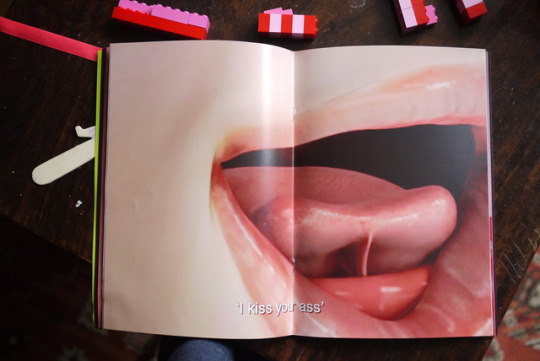
> Bookended by Roddick’s and Zaman’s radical re-orientating of the apparatus of academia – the introduction that resists assimilating each of the forthcoming pieces under one stable rubric, instead simply listing anonymously a sentence from each contributor in a process of meditative opening up, and ‘A note, before the notes. The end notes’ that counter-academically reveals weaknesses and vulnerabilities, is open to qualification and reframing, is responsive – Tongues constitutes a politics and aesthetics of ‘shift’. Collated after a staged exhibition, anticipating new bodies of work to come, and ultimately punctuated by a pamphlet that segues from reporting on an inspiring event that took place at the Women’s Art Library, Goldsmith’s University of London to imagining a second one in paper (the ‘original’ having been thwarted by bad weather), the entire collection has a productively stuttering relationship with temporality and with presence. As Shama Khanna writes about working groups and reading groups, workshops and pleasure-seeking in gallery spaces, this is the moving ground of the undercommons. It is testament to its intellectual lodestars – Sara Ahmed, Fred Moten, Stefano Harney, and, especially, the eroto-power of Audre Lorde. Along with Christopher Kirubi’s pamphlet, ‘Those Institutions Should Belong to Us’, which comprises a series of seven short ‘prose poems’ documenting the anguish of writing a dissertation from a marginalised perspective, the entire project of Tongues with Those Institutions is to upend academic practice, to recognise the ideological thrust of academic method, to stage fugitive enquiry. Kirubi’s plain sans-serif black font on white pages rehearses the anxious dialectics of interpellation and liberation (‘there is a need to see ourselves reflected in position of agency power and self determination in a world which does not really wish to see us thrive at all’ (part 3)) afforded by their academic obligations, but inarticulacy is a higher form of eloquence:
Even though I know at some point I am going to have to yield to these demands I feel I have to say now that I want to take in this dissertation a position of defending the inarticulate, defending the subjective and defending the incoherent, without having to arrive at a point of defence through theoretically determined foundations, but to feel them.
> Since its structuring principles are those of women’s work, and of Black and Brown experience, nurturing and shielding within the exhaustingly cyclical nature of toiling for recognition, respect, and protection, Tongues dances in the poetics of circles, of loops and feedback, of reciprocity and exchange. Recognising, however, that circularity is also the shape of repetitive strain, Zaman leaves us with a spiralling gesture, in homage to the Haitian spiral, ‘born out of the work of the Spiralist poets’ (p. 61). This ‘dynamic and non-linear’ form insists on the mutuality of the past and contemporary circumstances, is ‘a movement of multiplied or fractured beings, back and forth in time and space demanding accumulation, tumult, and repetition, adamant irresolution and open endedness…’. We are in that spiral now. Such demands must be heard, power must be relinquished, established forms of control – enacted in the streets and on our pages – must be terminated. Writing in early June 2020, this feels precarious; no one is exempt from giving of their strength.
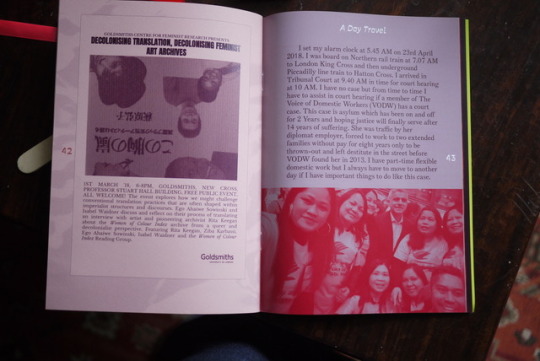

Please pursue further information here. If you are able, these organisations thrive (given the paucity of state support) on donation:
Voice of Domestic Workers: https://www.thevoiceofdomesticworkers.com/
Cherry Groce foundation: https://www.cherrygroce.org/
BBZBLACKBOOK (a digital archive of emerging & established black queer artists): https://bbzblkbk.com/
Reclaim Holloway: http://reclaimholloway.mystrikingly.com/
~
Text: Rhian Williams
Published: 16/6/20
1 note
·
View note
Text
U guys wanna know what I think about that hell hotel show
I feel like twitter’s very tired of seeing ppl talk about Hazbin Hotel, so I putting my opinions on tumblr where they belong. I’m not a “professional critic” by any means, but I’ll try my best given what I know. And don’t worry, I’ll be incredibly nit-picky to suit the internet’s needs.
I’m gonna mainly focus on HH itself instead of Vivzie’s accusations because that's a WHOLE other can of worms to open.
During the time of me writing this, I haven’t watched any YT reviews, but I’ve read a few threads criticising the show, so take that as my social influence bias.
My ted talk is allllll below the cut. Enjoy~
Context:
My first exposure of Vivzie’s work was her “Die Young” animation that I came across around 2016. Instantly I fell in love with how “smooth” and lively her animation was, and especially the fact that it was hand drawn. Animation like that was extremely rare to come by (and still is) and seeing her execute it so well with such complexed characters was amazing to my fetus self.
A few years later and I see the first trailer for HH. I instantly went OH I RECOGNISE THAT STYLE AND THOSE CHARACTER TYPE DESIGNS and was looking forward to what it had to offer.
On “opening day” I watched the pilot ASAP to avoid my opinions from getting warped by all of the key-mash memes and post call-out bitching (literally the extremes of the HH opinion spectrum), and overall.....
I thought it was good.
Not ground breakingly amazing, not horrifically terrible, but charmingly good.
(Ok now it’s actual review time)
Animation Quality:
As a hand drawn animation that has the freedom to get creative with its shots, a lot of effort was clearly put into how everything moves (it definitely didn’t take any lazy flash puppet shortcuts for the main sections of the show) and I can appreciate that. However it tends to be... rather inconsistent, most likely due to the varying skill level of the animators on the project. It’ll be nice and smooth one minute, and then awkward and choppy the next which can make the viewing pretty confusing at times. I’ll be honest I found myself overlooking these inconsistencies due to the characters and backgrounds themselves being very visually engaging, especially considering how over designed some of them can be (which I applaud the team for handling cuz wow that must have been painful). However, the needle thin and exaggerated art style makes some things incredibly hard to look at. While it helps with adding fancy details, it hurts in catching peoples eyes in the right place.
It’s also chalk full of little details, visual gags, and references that are hilarious to look at if you have the luxury of pausing every two seconds (the news segment and Sir Pentious turf war w/ Angel and Cherri are good places to look). But I feel like these lil details were put in at the cost of some some continuity errors (Charlie not wearing her coat in one shot, and having it back on in the next, papers being blank, etc.) and lip-syncing issues which really shouldn’t be happening considering all of the detail they were able to put in. There are also some shots that have just SO MUCH detail put into them, only to be shown for less than a second. I get that’s the cost of animation sometimes, but save the detail for the shots that need it, because at that point you’re just causing the animators to waste their efforts.
However, I was surprised at how professional the soundtrack and editing was. Not one but THREE songs in this single episode was really surprising, and the variation and quality of each was great (as cringy as Charlie’s song is)
But overall, the production quality is surprisingly good for a project like this, the editing, sound effects, and sound track act like a cherry on top. Of course there are some noticeable drops in quality, but given time and a budget, it has enough chops to look like an actual show.
Writing:
As far as overarching plot goes, it seems like it’s going to be one of those procedural shows that tries to be serialised, but it’s a creative twist on hell and has an interesting premise to begin with. You can get really creative with seeing how you’d dive into getting redemption out of all of these seemingly lost causes, and I’m sure there are many people willing to know the backstories our main cast. As a pilot, it did it’s job of launching the plot very well, setting up the premise of the hotel and introducing characters in a very engaging way. I was legit really interested in each segment with who in introduced, and it didn’t feel like I was being overloaded with names to remember (which can be a problem for many medias and introductions). The cohesion between each scene is VERY smooth, and I genuinely enjoyed some of the cliché cuts/gags.
Unfortunately I can’t extend this interest to our main character. Charlie is one of the most generic tropes we’ve ever seen. She’s a boring Disney princess who has a “cute happy positive goal to change her world” and the only thing that would make her more generic is if she wore a dress and cried “I’m tired of being so privileged”.
(Although it’s impossible to tell, I honestly think Viv is just projecting through her, especially considering how horrifically accurate the hotel’s opening mirrors the internet’s reaction to the pilot itself)
I would be more forgiving if she was a supporting character or someone less important, but she’s the freaking protagonist, arguably the character that has to be the most interesting. Angel’s personality seems to be “flirty porn star”, and while that’s just as bad as being a boring Disney princess, at least he gets a few jokes and has a profession more interesting than Charlie’s. Around the end of the pilot he just seems like he’s getting involved because Viv likes giving him attention. If he’s supposed to be leeching off of the hotel, wouldn’t not care if it survives or not?
(There’s that whole stereotype issue that everyone keeps bringing up, but I genuinely think that’s BS because people are blatantly ignoring the fact that Angel is a porn star, Vaggie is portrayed as helpful, and that the show takes place in H E double hokey sticks.)
The transitions may be smooth, but the dialogue pacing can get really awkward at times. This paired with the animation sometimes having awkward quality drops makes some movements incredibly jagged, and has some detailed shots show for incredibly unbalanced screen time as mentioned before.
I don’t have enough to give voice acting it’s own section so I’m just popping it down here:
The voice acting is legitimately better than several big name projects I know. It’s consistent, great at expressing the character’s mood properly, and each voice fits each character perfectly. My only gripes are that Alastor and Sir Pentious tend to grain on you after awhile due to them keeping a single tone for too long.
Character Design: AKA the only thing I have legitimate experience with.
First thing’s first. The characters are WAY too over designed. There are so many markings and accessories that are incredibly unnecessary. I think the mindset for these characters was “the more complicated and attractive the better”, which makes them look like they’re designed by an edgy tumblr artist (heck I fall for this too some times).
Especially if a character is going to be animated, you have to keep in mind the value of simplicity. You absolutely don’t have to fill in your character with markings and trinkets to make them look unique, I mean just look at the gen 1 pokemon starters. Thanks to the limitations of the game, the sprites were forced to be simple, and it was that simplicity that made them such unique and varied creatures. You can tell Blastoise is a bulky water blasting turtle just with a quick glance.
Many of the characters suffer from over complication, but I’ll look at Husk for example. He has these stripes all over him that do not contribute to who he’s supposed to be at all, and only look like they’re added to make him more unique. The markings that DO help are the little card suite marks on his wings, because those at least infer he’s linked to a casino/gambling type of theme. I would say his outfit helps as well, but formal wear and bowties are worn way to often by the main characters, which brings me to another problem.
They may look different, but they feel way too similar. From the same skinny body type, to generic head shapes, to outfits, the focus characters just don’t stand out amongst each other. Even the ones with interesting features still suffer from feeling generic. I’d say Sir Pentious is a good example of this. He has a serpentine/naga body and clever hair style that make his concept really creative, but his skinny body type, complicated eyes all over his tail, and generic “young but supposed to be at least middle aged” face just push him back into obscurity. He’s even wearing the SAME outfit as Alastor (who's an even worse offender of that generic face problem), and unless Viv has some plan to link the two, I’d say the characters need to stop using a dress code.
A successful character design can to tell you who the character is just by looking at them. You should be able to tell if a character’s personality, function, age, the universe they belong in, and if they’re important or not, and that’s a big problem when it comes to the background characters. If you pause on one of the extras for a minute you can see all of the effort put into designing them, and that takes away so much attention from the main cast. Not only that, but they have actual variations in their body types and outfits, which makes them more intriguing than who we’re supposed to be interested in.
Regardless, this pilot has potential, and if they can get someone to comb out the flaws, you can end up with something good. No one can deny a legitimate animation was made here, and the team successfully executed the start of a story, and that’s something anyone can look up to.
TLDR: The pilot is good. It has some major flaws, but it has potential to be a good show.
If you actually read this far epstein didn’t kill himself.
#I'm only doing this cuz i wanna draw angel dust and i feel like I have to justify myself before ppl start calling me mean things#Fan art is coming ;)#hazbin hotel#HH is good yall just have a mob mentality#critique
10 notes
·
View notes
Text
Translation: Kai Havertz portait in ZEIT newspaper (January 2019)
NOTE: Hey guys! This time I tried something new. I translated an exclusive portrait the german weekly newspaper DIE ZEIT did with Kai in January. They interviewed him as well as Kai’s family. Its very candid and has alot of details. I hope you guys like it, since DIE ZEITs writing is usually very difficult - even for germans. And I apologize for spelling errors as usual.
The original text in German
Kai Havertz: the peace itself
(January 23, 2019)
People praise Leverkusens national player Kai Havertz, 19, for his serenity with the ball which put him on the radar of many European top clubs. His parents start to realize that he is likely becoming world famous.
By Jörg Kramer

The most promising german football talent these days picked a table very far behind in an restaurant somewhere in Cologne to order himself some spagetti gnocchi – inconspicuous.
There is no star posturing with Kai Havertz. The 19 year old could even go through as a normal university student; with his bright hoodie and somewhat cheap and not even special occurence.
And with his voice, which has this typical regional dialect, without the typical empty phrases that young football player use to often in order to cover up their meaningless sentences. But people know his face by now. So thats why he doesnt sit right next to the entrance.
He belongs to the celebrities of the football scene. European top clubs are scouting the young men in stadiums, team mates from Bayer Leverkusen praising him and forecasting him to have the potential to become a world star.
He already scored nine goals this season, decided some games by his own and played his first games for the national team. Havertz became the centre of his clubs game by playing at the centre midfield. His role only changed slightly and the importance of his role not at all, since Peter Bosz took over as head coach. He views this very relaxed and talks in an restaurant somewhere in the Belgian Quarter of Cologne about Leverkusen being the „perfect place“ in order to develop as a young player. And thats where he wants to give his all for the last half year ahead. Ooops!
His last half year? That was a slip of the tongue of course, he meant to say the next half year. Because his contract with Bayer is still running until 2022 without an exit clause. But things now are developing in a rapid way which runs parallel to his explosive performance currently. Its just a matter of the perfect timing that someone like him will end up going to Barcelona, Manchester or at least Munich – a choice between summer 2019 or summer 2020 maybe.
Havertz walks over his misspelled sentence like nothing happend. Once in Nuremberg in the middle of a turmoil of an rainy game, it seemed as if he stopped – as if he was reconsidering the situation with him having the ball. Like if somebody pressed a ‚Stop‘-button. And he chiped to ball in an cool and unemoitional and scored.
Coaches and team mates are citizing his body language, he says. So he works on looking more aggresive. He even participates on useless discussions between his teammates and referees after controversial decisions on the pitch, in order to get a penalty for the other team or some revenge. But it doesnt really look good him when he does it, he admits – even after a though tackle or when going after the ball. „I’m a player that shines with his tranquility.“ A nice sentence that gives away his elegante style of play.
Havertz remained an artist on the pitch. Every foul is a sign of weakness. Everytime he gets the ball, which is his job as an offensive player, he never runs into his opponents – he anticipates. „I try to imagine, which options my opponent has, what he would do if I were him.“ He then runs with a planned pass way and he gets the ball.
Havertz learned in the past almost two and a half years all systems and tatics of modern football. Starting with a radical system, almost a raid-strategy under coach Roger Schmidt, by which the goal keeper kicked the ball high and it flew wide over the pitch – almost always directly aimed at Havertz‘ head – because he is 1,88 meters tall.
Then the mixed system under Heiko Herrlich. He always had to look for his team mates before he passed. Now with Bosz, a planfull offensive style with flat passing. He runs through all the chapters. The first began on October 15, 2016.
It was a Saturday. A day where the Havertz family from Mariadorf near Aachen still couldnt realize that their youngest son, will probably end up living off football and perhaps even become famous. They cant really believe it up until today, says Anne Havertz, his mother.
On that day – October 15 – Kai was a youth player, in a big house next to the woods in Mariadorf having breakfast – when suddently coach Schmidt called. Lars Bender, professional Bayer-player who was supposed to play against Werder Bremen that evening, got injured and had to quit. Kai had to come to Bremen, immidiately! His mother drove him to Leverkusen. A special shuttle took him to Bremen. His whole family was sitting in front of the TV that night.
Kai was sitting on the bench as expected. Then, during the 83th minute, the commentator saw already more than the viewes and said: now we are experiencing a debut. Kai Havertz was ready to get subbed. In the real Bundesliga. Anne Havertz said: „Oh my god!“.
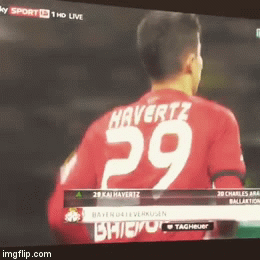
(Credit: Instagram: kaihavertz29)
Kai’s mother, who worked as a lawyer until she got pregnant with her eldest son, came to the restaurant in Cologne one day after Kai to talk about life as a family of an future world star. She brought her husband – Kai’s father, and her daughter Lea, Kai’s sister. The sister is studying marketing and digital media in the city.
People can reach his father in an emergency by dailing 1-1-0. He is a police officer working at the police station 3 in Cologne-West. He says he is really impressed, about how cool and routinely his football playing son manages post-game interviews and how we stays cool when people recognize him in public and everybody is watching,
The Havertz family is still perplexed about a football world where colleagues of their son, order their own cooks to cook for them at home. And whenever he puts his legs into an special bag in order to regenerate. Almost the whole family – except his oldest brother and the dog – are having apple pie and salate and looking back at the stages of his career, which started at Alemannia Mariadorf. Kai skiped two age-groups. He then played with older players than actually intended. Then he transfered to Bayer Leverkusen. All because the scout was tough but not intrusive like the other scouts. By the age of ten, Bayer drove Kai to training sessions three times a week.
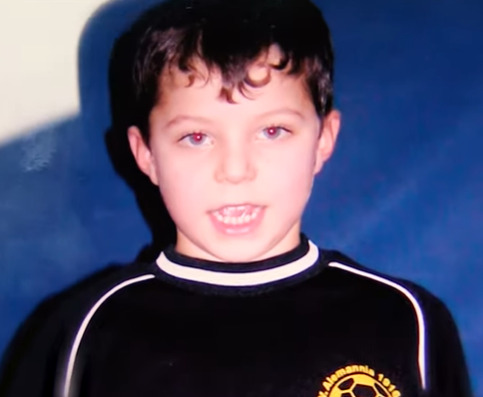
4 year old Kai Havertz (Credit: kicker tv)
He was still among the smallest players in the team by the age of 14. Then suddently - a growth spurt which resultet in issues with his knees and his back. They were responsible for Kai loosing his fixed spot on the team. This was also the hard time because he left home and moved to Leverkusen. The club doesnt have an academy so he stayed at a guest family – the family of the stadium announcer from Bayer, together with two other players. A year later he moved into an apartement with his older brother, until Jan had to move to Nuremberg – he has a marketing job at adidas now.
A lasting memory: endless discussions within the Havertz family about the overarching question: does the boy need a german high school diploma (Abitur)? Will he pass the tests when he is travelling around with his professional teammates?
Kai Havertz attended the Landrat-Lucas-Gymnasium. An elite school of sports where he could skip classes in the morning for training. But he always had to catch up school stuff from the day. Once he played with Leverkusen at the DFB-Cup at Sportfreunde Lotte. He was subbed late, it went into penalities and after the team was eliminated from the cup he arrived home late – at 3am. At 8am he had an English exam.
The family became a team. His mother and sister helped him with biology exams. One day the young football player said to his family, he has no power left anymore. „But he never said: I want to quit!“ his mother insists. This was a breaking point by which his parents thought about quitting and stop pursuing the Abitur. But suddently coach Roger Schmidt intervened and said Kai should pull through. The whole Bayer team will support him.
The Abitur became a factor of will power, a test of life. The school supervisor of Bayer, a former athlete herself, said something memorable: it will shape his whole life if Kai quits school now. Whenever something becomes difficult, if something goes beyond your pain barrier, he will always have this option to quit in his head, that you can just give up.
Kai Havertz choose the pain, the Abitur. Now he will always choose the hard way if the theory of his supervisor holds.
On this January afternoon in Cologne, he is being asked what other job he would have picked if it wasnt for football. He likes the job as a barber, for men’s hairstyle. He smiles. Some curls are hanging on his forehead from left to right. A Barber. He wouldnt have needed an Abitur for that.
He is a genius at football. He won the German junior championship with Bayer and scored 19 goals in 29 games. He got awarded as a Under-19-player as the best of his age with the Fritz-Walter-medal from the DFB. Kai made it onto second place on his position after Marco Reus from Dortmund in a list of the football magazine „kicker“ which they publish every half year – but seven spaces in front of Munich’s Thomas Müller.
Coach Heiko Herrlich says Havertz reminds him of Toni Kroos. Football critic Reiner Calmund compared him to Franz Beckenbauer. His head goals remind him of Michael Ballack. Mesut Özil was always Kai Havertz idol, because of his tranquility with the ball and his ability to read a game. Sometimes Kai misses the final conciseness in front of the goal, which was visible after the recent 0-1 loss against Borussia Mönchengladbach.
Having the ability to remain calm, even when you get tackled is the result of a deep confidence in your own strenghts: screen your surrondings – in short time if necessary – and then make the right decision. Joachim Löw praises Havertz „good orientation“, something he said about Özil years ago. What he means is a certain sense of space on the pitch – an inner compass. Something that has to do with attention and memory. Havertz, who is a master of navigation, doesn’t even need practice. Some creatures have special senses and are able to find orientation on earth through a magnetic field – like migratory birds for example.
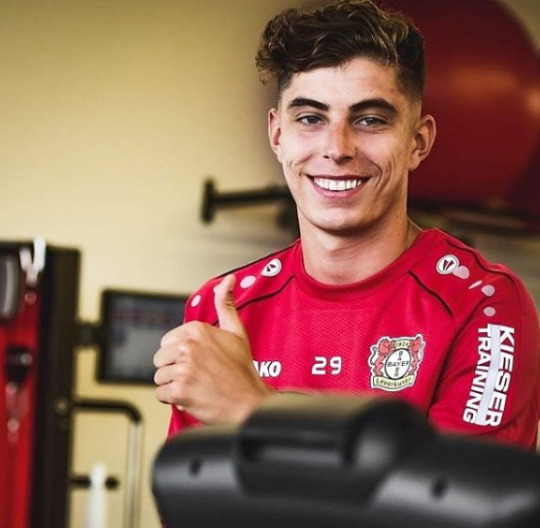
Kai Havertz likes watching Champions League games. And while watching them, there is always a wish inside him to participate as well whenever the big games of the quarter- and semifinals are on. „I think you can only reach that level by going to a top club at some point“ he says.
Mother, father and sister Havertz say, they don’t expect things from him. Something they never did in his career. But if someone asks them, who will follow Kai in a foreign country to get used to everything – they start to think about it. They would alternate. One week his mother would visit, next week his sister and then his grandmother maybe.
Kai Havertz still has a room back home in Mariadorf. Back in the day he used to have posters from FC Barcelona. So it could happen maybe one day, that youngsters in Barcelona will have posters with Kai Havertz on them.
++END++
#kaihavertz#kai havertz#bayerleverkusen#bayer leverkusen#German NT#diemannschaft#DFB Team#dfb#bravertz#julianbrandt
27 notes
·
View notes
Text
Retro Roulette #82: Wario Land: Super Mario Land 3 (Game Boy, 1994)
Oh crap, I need to find out if I have a Game Boy that works. Let’s see...

Whew! Here it is, in all its barely visible glory.
Wario Land: Super Mario Land 3 is the first game ever to feature Wario as a playable character. He was introduced as a villain the previous game in this series, 6 Golden Coins, and was apparently enough of a hit that they *immediately* put him front and center. I’ve never quite understood the appeal, to be honest.
The story of the first few Super Mario Land games is amusingly interconnected - during the events of the first game, in which Mario is in an unusual kingdom called Sarasaland, Wario took over Mario Land and steals its namesake castle. Super Mario Land 2 is all about undoing that, and at its end, order is restored when Wario is expelled from the castle. Undeterred, Wario resolves to get a castle of his own, which will be cooler and better than Mario’s, which brings us to this week’s game.
This game also introduced Captain Syrup, the first female villain of the overarching Mario universe. She was also the villain of Wario Land II, but hasn’t hasn’t shown up in much since.

If you’ve played literally any Mario game, you should have a good idea of how this works - Mar...sorry, Wario - jumps on platforms and enemies, collects coins, and tries not to die. Like his less evil counterpart, Wario can dash to move more quickly, and can collect a handful of different powerups. He’s got some cool ones, too - a set of horned helmet him extra strength when barreling through things, and a winged helmet lets him fly horizontally for a pretty solid distance.

The game has an overworld reminiscent of its predecessor, or like Super Mario World. The levels themselves are just numbered, though, which is a bit frustrating - this makes it needlessly tough to, say, remember a particular level that you enjoyed. Even considering how the game is somewhat hampered by the limits of the Game Boy, a lot of the levels feel fairly uninspired, and most are disappointingly easy. There are a lot of them to play through, though, and they’re certainly well-made, but this falls a bit short of feeling like a big, varied Mario release.

In general, the bar for top tier Mario-adjacent games is very, very high - to no fault of its own, Wario Land doesn’t really belong in that tier. It’s a pretty fun game, though - I’d especially recommended for a young retro gamer who wants to work up to a bigger challenge. It’s a great pick for that.
Wario Land was, as you can probably guess, a pretty big hit - it made the character a mainstay of the Mario universe and spawned numerous sequels of its own, including what is probably the best game for the Virtual Boy, the appropriately named Virtual Boy Wario Land.

Let this serve as a reminder that literally all Virtual Boy games look like that. Wario’s popularity also led to the creation of the delightful WarioWare series, which generally consists of a series of frantic, weird micro-games. While I don’t know that I’ve ever fully gotten the appeal of Wario himself, WarioWare is easily one of my favorite Nintendo franchises.
Next week’s game is a 16-bit racer that I apparently own but have never heard of. That might be good? You can’t say it won’t be. Here’s hoping you’ll come back to find out.
#mario#wario#warioland#wario land#super mario#nintendo#game boy#retro games#retro gaming#retrogaming#retro video games#video games#retro roulette#virtual boy#captain syrup
13 notes
·
View notes
Text
With the impending release of his fifth studio album — the first since the four-time platinum, Grammy-nominated 2016 Views — Drake has many questions surrounding him. Can he again move a million units in a week? Can he prove all the doubters wrong after two years of ghostwriting allegations? Can he top “Hotline Bling” or “One Dance”? Can More Life overtake Take Care as Drake’s undoubted classic album?
EDITOR'S PICKS
The Best Drake Album That Never Existed
CulturePlay: Rick Ross
Nike hijab opens the door for female athletes of all faiths
‘Get Out’s’ Kaluuya responds to Samuel L. Jackson’s comments about black British actors
25 Books To Save Your Life Right Now
But also, can he, like so many artists in 2016 — Beyoncé (Lemonade), Solange (A Seat at the Table), Rihanna (Anti), Kanye West (The Life of Pablo), Young Thug (Jeffery) — take risks on his new album, exposing a deeper version of himself? Drake and his legion of fans — and his seemingly equal number of detractors — are waiting with bated breath for March 18 to see what the 6 God has been cooking up. But before we can call the new project “classic” or “trash,” before we spend the next few weeks debating the best and worst tracks, here’s the most important question that Drake has to answer: Can he stop attempting to control women?
Over the past eight years, Drake’s built up a reputation as being the compassionate and less threatening (read: soft) rapper who appears on The Ellen DeGeneres Show, cuddles up with professional athletes, and gets tattoos of Aaliyah. He’s played the role of Nice Guy by constantly smiling, and apparently wearing his heart on his sleeve. This appeals to the sensitivities of the women in his fan base. But, as is often the case with these so-called nice guys, Drake plays the charmer — he’ll call you beautiful, open doors for you and send you smiley-face emojis — but the minute he has sex with you, or you move on to someone else, he turns into Michael Ealy in The Perfect Guy.
Drake’s corniness, outward kindness and lack of sexual aggression has been misinterpreted as an overarching respect for women. He’s even been referred to as a feminist. But Drake is as much a feminist as Rachel Dolezal is a black woman. His entire catalog is steeped in respectability politics, accepting women so far as their body count goes.
Those songs pale in comparison to “Shot For Me,” “Marvin’s Room” and “Practice.” They are Drake at his worst.
While he’s constantly praised Nicki Minaj over the years, Drake belittled the Grammy-nominated artist during his beef with her former boyfriend, Meek Mill — Is that a world tour or your girl’s tour? — implying that it’s emasculating for a man to receive second billing to his significant other.
ADVERTISEMENT
As with stars of rock and country music, almost every successful rapper today, from Jay Z to Future to Chance the Rapper, has at some point performed lyrics that objectify or exploit women. J.Cole’s music has taken on more social justice elements over the years (Drake has spoken out for black causes as well). But Cole, in a 2013 song, called women “b—–s” —I got smart, I got rich, and I got b—–s still/And they all look like my eyebrows: thick as hell — and patriarchally dismisses female sexuality on 2014’s “No Role Modelz”:
My only regret was too young for Lisa Bonet, my only regret was too young for Nia Long/Now all I’m left with is hoes from reality shows, hand her a script the b—h probably couldn’t read along
Even so-called progressive rappers fall into this trap, namely the androgynous Young Thug and the genderfluid Young M.A.
Sometime between Drake’s early rise and his third mixtape being converted into 2009’s So Far Gone, the rapper known for singing about his romantic feelings and the pressure of newfound fame — with a flow that made every 16 bars sound like the hottest verse ever — became his own worst enemy. Drake, known for hits like 2009’s “Best I Ever Had” and 2010’s “Find Your Love,” became synonymous with quote-heavy memes on social media, and fake Twitter accounts such as @drakkardnoir pumped out fake deep quote after fake deep quote.
But the rapper’s verses about loving and being proud of college-educated, independent women — Sound so smart like you graduated college/Like you went to Yale but you probably went to Howard — paved the way for hypermasculine diatribes against the sexual agency of seemingly any woman he’s ever encountered. Through an examination of Drake’s four studio albums, plus mixtapes, collaborative projects and guest features, it is clear that the man who made music for folks who couldn’t get over their exes was himself struggling with the basic concept of “moving on.”
While So Far Gone doesn’t count as a studio album — it was his final mixtape before signing with Universal Republic — it gave listeners a sneak peek into the troublesome lyrics Drake would release in subsequent years. On the soothing track “Houstatlantavegas,” he raps about “saving” an exotic dancer from a strip club:
You go get f—– up and we just show up at your rescue/Carry you inside, get you some water and undress you.
I give you my all and the next morning you’ll forget who or why, or how, or when/Tonight is prolly ’bout to happen all over again.
Thank Me Later, Drake’s 2010 debut studio album, features the rapper slut-shaming women for having previous sexual partners. From “Karaoke” (I hope that you don’t get known for nothing crazy/Cause no man ever wants to hear those stories ’bout his lady) to “Miss Me” (Work somethin’, twerk something, basis/She just tryna make it so she’s right here getting naked. I don’t judge her, I don’t judge her/But I could never love her) to “Thank Me Now” (Alohas to women with no ties to men/That I know well, that way there are no lies), Drake positions women with previous sexual experience as undesirable. On the Rihanna-assisted “Take Care,” he seems to open up to the idea of women having sexual agency, relenting I’ve asked about you and they told me things/But my mind didn’t change and I still feel the same.
Thank Me Later was also at times a celebration of independent women – appreciating women’s “book smarts and street smarts” on “Shut it Down” and “Fancy” — but set the foundation for 2011’s Take Care, which was, at that point, the peak of Drake’s overt misogyny and objectification of women. On Take Care, which won Drake a Grammy for best rap album — he continues his focus on sex workers with “Lord Knows”:
To all these women that think like men with the same intentions
Talking strippers and models that try to gain attention.
Even a couple porn stars that I’m ashamed to mention.
“Under Ground Kings” (Sometimes I need that romance, sometimes I need that pole dance/Sometimes I need that stripper that’s gon’ tell me that she don’t dance) even creates a binary of acceptable and unacceptable behavior. While Drake has an infatuation with exotic dancers, he also makes it clear that admiration only goes as far as sex. “Trust Issues,” which Drake said he made for “fun” and thus didn’t include on the album, has Drake playing into the thoroughly debunked myth that women can’t want sex as much as men, rapping And it’s probably why I’m scared to put the time in/Women want to f— like they’re me and I’m them.
Those songs, though, pale in comparison to “Shot For Me,” “Marvin’s Room” and “Practice.” They are Drake at his worst, going beyond the behaviors of the paternalistic and disapproving ex. He goes from telling a woman she’s drinking away the pain she feels due to leaving him on “Shot For Me” — Yeah, I’m the reason why you always getting faded — to cursing out another for finding happiness with a new lover on “Marvin’s Room” (F— that n—-a that you love so bad).
Despite admitting that he’s a flawed individual in the latter song, in the former he tells the woman that he “made” her and calls her a “b—-.” This then leads to Drake’s most confusing and disturbing song to date, “Practice.” While acknowledging that women can have sex — the song is about a woman having multiple partners — Drake then spins it to his advantage: All those other men were practice, they were practice/Yeah, for me, for me, for me, for me. He senses “pain and regret” in the woman from her past, and then reluctantly accepts the fact that she has casual sex. He tops the song off with an uncomfortable, familial request: You can even call me daddy, give you someone to look up to.
But, Drake can still change. His lyrics paint the picture of a man who is constantly questioning himself.
It’s 2016’s “Hotline Bling” that ignited the re-examination of Drake’s entire catalog. The song is the rapper’s second-best-selling single of all time (behind fellow Views track “One Dance”), and won him two Grammys at last month’s award show. Not to mention, the visuals for the song will go down in music history as one of the most memorable music videos of all time.
But while the chorus is equal parts infectious and mesmerizing, Drake sneaks in two verses and a bridge full of “reductive stereotypes” and body-policing lyrics about an old fling. Whether about said woman “wearing less and goin’ out more” or “going places where you don’t belong,” Drake makes it apparent that he’s offended that she has the audacity to move on with her life. By the end of the song, Drake’s become so desperate that he’s even concerned that the woman is “bendin’ over backwards for someone else.” Textbook narcissism.
His guest appearances have been a mixed bag as well. On rapper The Game’s 2011 track “Good Girls Go Bad,” Drake raps Who’s still getting tested?/Where’s all the women that still remember who they slept with? and a year later added to 2 Chainz’s “No Lie”:
She could have a Grammy, I still treat her a– like a nominee
Just need to know what that p—- like
So one time is fine with me.
Over the past couple of years, Drake has put out two mixtapes, a solo effort If You’re Reading This It’s Too Late, and What A Time To Be Alive with Future. His male chauvinism can be found on tracks “Legend,” “Energy” and “Madonna” and repeatedly calls a woman “ungrateful” for living her life without him on “Diamonds Dancing.” As writer Tahirah Hairston pointed out, Drake has also had questionable lyrics on “Wu-Tang Forever,” “Own It,” “Furthest Thing,” “I’m The Plug” and even notable feminist Beyoncé’s “Mine.”
Back in October, Drake released three tracks from his upcoming More Life album — “Fake Love,” “Sneakin’,” and “Two Birds, One Stone.” Looking solely at those tracks, it appears Drake has let up a little on his control, instead rapping about success, fake friends and his long list of haters. Even his appearance on labelmate Nicki Minaj’s diss to Remy Ma, “No Frauds,” he steers clear of trying to preserve women’s sanctity.
For nearly a decade now, Drake has wrapped up his alarming lyrics inside catchy, Instagram-caption-worthy choruses and tunes. The “light-skinned Keith Sweat” gets away with this because he carefully crafted a “nice guy” persona that deflects the criticism that, say, a 21 Savage, Kodak Black or the Migos would receive.
For many men, Drake’s attitudes reflect their own attitudes and desires, which in turn reflect a patriarchal society that views women as sexual objects meant to be gazed at. For women, they’ve had to deal with sexism in the arts since the beginning of time, so choosing to not enjoy an artist because of his views on sexuality would mean giving up on music all together. And at the end of the day, Drake is just that good at his job, unquestionably the most influential and popular musician in the business right now.
But Drake can still change. His lyrics paint the picture of a man who is constantly questioning himself, consistently trying to become a better person, whatever that entails. From So Far Gone to More Life — age 22 to 30 — he’s learned all the lessons life can teach, from whom to trust to what forms of happiness money and fame can buy. But it seems he’s yet to learn that women aren’t sexual objects. They’re human beings. If the only women of the world were all exactly like the women he seems to respect — his mother or Rihanna or Aaliyah or Serena Williams — we’d call him Aubrey the Riveter. But, they aren’t the only women who deserve his respect.
He knows that. But it begs the question: Does he care?
Martenzie is a writer for The Undefeated. His favorite cinematic moment is when Django said "Y'all want to see somethin?"
0 notes
Text
4. Yujin Lee & Prima Jalichandra-Sakuntabhai (part 1)
Yujin Lee and Prima Jalichandra-Sakuntabhai discuss Paul Chan’s article, “What Art Is and Where It Belongs,” artistic production and its relationship to capital, making art for (or not for) a Western art audience, their interest in collaborative/process oriented projects, and whether or not one can be free as an artist from the intersecting systems of global capitalism and white supremacy that make up the art world. Read part 2 of their conversation here.

Yujin Lee (YL): Hi, Prima! First of all, thank you so much for accepting my invitation! I see that you received my email with the link to Paul Chan’s article, “What Art Is and Where It Belongs.” I suppose I will start with this obvious question. What is art to you and where do you think it belongs?
Prima Jalichandra-Sakuntabhai (PJ): Hi Yujin, thank you for sharing the Paul Chan text. It was indeed an interesting read! To your question as to “what is art to me and where I think it belongs”, my job as an art handler has deeply affected how I view art. I can no longer see art as a product of a singular mind but rather, an object that exists in relation to multiple networks. Paul Chan is generous in giving art the definition of a “more than” an object by the way that it expresses what an object desires to be. I would argue that art is only “more than” an object because it’s value is not intrinsic to its material properties and use-value but the cultural value assigned to it by a number of actors. When I was in undergrad I came across this book called, Worlds of Art (Les Mondes de l’Art) by Howard S. Becker. Anyway, he was one of the first authors to place art and artistic production in a chain of labour production from administrative works of post-production and marketing to intellectual works from universities and curatorial work. That vision of art is more true to me in my daily life than the art that is heralded for its poignant inquiry into humankind’s psyche and advancement of what we call “civilization”. So the simple answer to your question may be that art belongs to capital and serves those who can afford its production and consumption. But at the same time, while I serve as a clog in this system, I also want to make an art that can exist outside of the system and truly be moments of disconcert with the real. My current show is up at a gallery that used to be a storefront in a shopping plaza in Chinatown, Los Angeles. The interface with a non-art audience is inevitable. The projections attracted attention and the occasional passer-bys waiting to pick up their food would stop and talk to me. But the conversations remained fairly surface. None of them have yet made an appointment to intentionally see the work. Not to mention the heightened tensions caused by art’s complicity in gentrification. So, even in a public-facing space, art can only rely on its existing structures and those who already have access to them.
Since you work a lot with the public and collaborations, I wonder how the experience has been for you and whether you believe art can belong outside of the art world itself?

Prima Jalichandra-Sakuntabhai, Chloropsis Aurifrons Pridii, 2021, performance and multi-media installation, 2 video projectors, 2 overhead projectors, transparencies, colour filter, printed black and white images on photocopy paper, books
YL: I completely agree with everything you said about the complex networks that build up a work of art (and the artist’s career). Come to think of it, when has art ever been outside of that system? One example comes to mind that relates to how Paul Chan began and ended his article. Chan begins with a very “kitsch” painting that he purchased for thirty dollars in the streets of New York and an unexpected challenge in finding the right place to hang it in his home. And he ends the article with, “For art to become art now, it must feel perfectly at home, nowhere.” This beginning and ending reminds me of the Korean shaman paintings (portraits of the indigenous gods). Even though the tradition goes far back in history, not many of these paintings remain. They were either burned or buried because people believed that the painting is a physical dwelling (or a seat) for a particular god served by a particular shaman. In most cases, the artist is also unknown and unimportant. Moreover, up until the late 80s, art collectors refused to collect shaman paintings as they are not merely powerful paintings (as an art object) but empowered paintings (as sites of divine presence). Despite it all, if it somehow falls into a collector or enters the museum, it is believed to become what Marx called the commodity fetish, losing its power, thus losing its value. In this case, the art object, artist, and collector all have no place! This may be why shaman paintings have not been considered “art” for so long by its creators, users, and admirers. So for me, it’s not a matter of whether art can or cannot belong outside the “art world,” but that “it must feel perfectly at home, nowhere,” or that it must feel perfectly at home, everywhere. I test this theory by experimenting with process-oriented, collaborative, performance and relational art.
I watched the video documentation of the performative lecture installation that you’ve mentioned, Chloropsis Aurifrons Pridii, at The Fulcrum Press. The collage of your voice with the light and shadow of texts and images created by multiple projectors choreographed by the subtle gestures of your hands… It was a sensorial and immersive experience, even through my computer monitor. The occasional sound of the machines turning on and off took me in and out of this poetic narrative. I was also compelled by the intricately untangled individual journeys of your family members crossing three generations, and your re-interpretation of the overarching macro history that wolves together three continents. The most memorable moment was when you said, “... Both view history as driven by cycles of reincarnations. Within one body, one consciousness, are contained centuries of all earthly desires, unquenched. History thus progresses as a movement of return. For the last five years, I face the Pacific and the fear of a return.”
Having said that, I wonder why contemporary art often appears to be disparate from the rest of the world. Sometimes even alienating and elitist. Judith Butler actually defends this position quite eloquently:
“Who devises the protocols of ‘clarity’ and whose interests do they serve? What is foreclosed by the insistence on parochial standards of transparency as requisite for all communication? What does ‘transparency’ keep obscure?”
This statement may sound like art gibberish to the non-art audience and support your disappointment of the disinterest displayed by the non-art audience in Chinatown. But I wonder, what does it mean to desire the interests of the “non-art audience”?

PJ: First of all, yes to process art works! I think our two approaches to art practice staunchingly demarcate us from “the commodity fetish” that most high art/internationally-recognized art ends up becoming by the very fact that we care less about the end product and more about the creative process themselves. The process can take shape as a form of knowledge or a set of techniques that in my case, takes on a certain shade based on my personal narrative. But taken up by someone else, the combination of voice, body movements and layering of images that you noted, would express something else entirely. That is what I am interested in in achieving: rather than creating an original product, I want to redefine techniques and processes of thought. I think the relationality and collaboration in your work that I’ve seen at VER and what you continue to do at your residency in Jeju strive for a similar balance between the creation of processes and the specificity of the people you engage with.
This reflects the other side of our art practice: although it is defiant of consumerist art, it is still bound to the Western art canon. Even a working against or criticism of Western art canon asks the audience to be aware of the canon to understand our respective positions. I respond strongly to you raising the example of the Korean shaman paintings (of which I know nothing of!) as being uncollectable and therefore, not considered art. In this case, its power operates in a culture that is closer to the non-art audience. It doesn’t need to invent value for itself but its symbolic code is embedded in the culture that receives it.
That is why I am saddened by not being able to touch the “non-art audience”. I believe that I envy the power of the shaman paintings, a power that can touch anyone without necessary prior knowledge. That is what I lament in operating in the current art world that I am in. At the same time, I do deeply agree with you that the demand for clarity and the parochial is a form of holding back of thought and the need to plunge in the mystery that is sometimes too specific for the artist themselves to put words to. That is perhaps why I still value art over other forms of knowledge: art can give shape to what is previously unknown. I also don’t mean to juxtapose the shaman paintings versus the inaccessibility of high art, as if one holds more intellectual value than the other. What I simply want to highlight is the different levels of reception that each form allows for.
YL: It’s true that the non-art audience (who may not necessarily understand the painting’s aesthetic value nor its symbolic meaning) are likely to succumb to the power of shaman paintings because of its deep-rooted history that vibrates within the culture. Do you know about the Swedish artist and mystic, Hilma af Klint? I think she didn’t give two cents about the art or non-art audience. Af Klint considered her experimental paintings (the first Western abstract art known to date) too avant-garde for her contemporaries and rarely exhibited them in public in her lifetime. Meanwhile, her so-called Theosophical art, which was heavily influenced by Buddhism and Hinduism, interestingly brings us back to the Korean shaman paintings. Before creating a shaman painting, one is to take a good bath, wear clean new clothes and oftentimes chant a prayer. Af Klint did something similar. Before starting a new series of paintings, she dedicated many months of “purification” by adjusting her lifestyle, like practicing vegetarianism. It may sound like a frivolous formality, but it demonstrates a belief on how the creator’s (artist’s) personal life cannot be severed from their creation (art), even if the admirers (public) may never know or care about the creator to begin with.
I’d like to go to your comment on how art “can give shape to what is previously unknown.” Chan also states that “in art, the only ideas worth realizing are the truly untenable ones.” I seriously weighed this concept (of art giving shape to obscurity) during my exhibition in Bangkok at the end of 2019, especially through the work you mentioned earlier, Drawing Conversation 2.0, a series of collaborative live automatic drawing performances created with local Thai artists. The obscurity for me at the time was the uncomfortable reality of having a solo show at a place where I did not understand its native language, culture, nor history.
A smaller room attached to the main gallery was dedicated for this work. The walls were painted black, and the floor laid with a dark grey carpet. A square table (around 30 cm in height) was placed in the center of the room where a blank sheet of paper covered its entire surface. A large scale drawing titled, In the beginning was___, was hung along with 5 other blank sheets of papers ready to be conversed upon. Drawing materials such as graphite, charcoal, eraser, and pen (no colors) were provided. For each session, a local artist was invited to create a drawing with me in silence for 108 minutes. A timer was set on my phone. The audience could freely enter and exit the space, sit, stand, or walk around us. The first ten minutes or so felt highly performative. But as more of our marks, gestures, breaths, and bodily heat crisscrossed, I experienced a kind of a (collective) trance. And when the timer went off and broke the silence of the room, the familiar ringtone of an iPhone sounded like the Korean shaman bell, bringing everybody in the room back to the present time and space. I think maybe this was my closest attempt in creating an “empowered painting.”

Yujin Lee, Drawing Conversation 2.0, Nov. 29, 2019, collaborative live drawing performance with artist Dujdao Vadhanapakorn, 108 minutes, Gallery VER
YL: Back to Chan… He asserts that “art and life would rather belong to the world than be free in it.” That is a bleak outlook for art, don’t you think? So, my question is, can we imagine art to be free in the current world (of capitalism)? I wonder what your thoughts are on this last point, and could you expand your thoughts on “art giving shape to the unknown” in relation to how you use language/text in your work?
PJ: Two big questions! [laughter]. I think it is a good question because we’re working towards agreeing that art is more often than not, not free in capitalism but can there be instances where they are…
YL: I thought that the last part of his text was interesting because when he’s saying “art and life would rather belong to the world,” it has a negative connotation... contrasting to what follows, “rather than be free in it.” Also you would think that he meant to say, “be free from it,” suggesting an escape from the world of inequity. But he’s sort of saying even within the system, art can be free inside of it, right? I thought that was an interesting, nuanced statement, and I want to pose this question to you, since you are still in the system, the LA art scene.
PJ: Are you saying that you’re not part of a scene because you are in Jeju?
YL: [laughing hard] That’s how I felt when I moved to Jeju, but with COVID I don’t think that’s true anymore because the internet in some ways amplifies the presence of the international art scene.
PJ: I think art has always been in network and in communication across borders and that capital gives more value to the kind of art that travels or is part of the international scene. LA or New York may have a very specific local scene but these major cities give the impression that if you’re part of their local scene, you’re somewhat seen internationally. So I think that art still depends on this kind of network. But the thing that is different with COVID is that people are more proactive in participating across countries and timezones.
YL: Yeah, that’s actually what I mean. I thought I left, by relocating to an island, a countryside, but COVID definitely brought me back to the network.

Yujin Lee, Painting Conversation, 2021, collaborative drawing performance with artist Jo Ahra, paintings completed over 4 sessions (March 19th, 21st, 23rd, 28th), Next Door to the Museum Jeju Artist Residency completed painting used as a costume for an improvisational dance video (work in process)
PJ: I want to also argue that maybe even if our locations are specific, that doesn’t mean that we’re not part of a larger network that has formed us.
Whether you like it or not, your context will always be informed by the experience you had in New York.
YL: You’re right. I thought, ‘physically leaving New York= leaving the art world.’ But the reality is, like you said, my experience as an artist is based on my time in New York. So, I’m probably going to carry that with me. So back to my questions on Chan’s statement… We’re all part of this world that is not very equitable... How can we be part of it, yet “be free in it?”
PJ: I want to believe that there is some sort of freedom. When you give away a certain part of the bargain and that bargain being monetary or investment by some sort of institution to give value to your art, to me, by abandoning that, I feel much more free. And I’m able to have full ownership of decisions around my work, which would not be the case if I was trying to respond to a certain expectation.

Prima Jalichandra-Sakuntabhai, Seven Springs, 2019, Collaboration with Chris McKelway, 2 violins, 2 overhead projectors, images printed on transparencies, colour filters

Yujin Lee is a Jeju-based visual artist working with drawings, performances, videos, and audience-participatory projects. Interested in the Buddhist concept of yuanqi (interdependency), Lee have pursued collaborative projects with artists Emi Hariyama (108 Bows, 2013), Nicole Won Hee Maloof (Same/Difference, 2015), Aracha Cholitgul (im_there_r_u_here, 2020~ongoing), and Jo Ahra (Untitled, 2021~ongoing). Since 2019, she has been running an alternative artist residency at her farmhouse, Next Door to the Museum Jeju. Lee received her MFA in printmaking from Columbia University and a BFA in painting from Cornell University.
leeyujin.com @jejuanarchist
Prima Jalichandra-Sakuntabhai is a transdisciplinary artist, working across performance, video and installation, based in Los Angeles. Born in Thailand in 1989, they were raised in Europe before moving to the US in 2011. They received their Visual Arts Degree from the Ecole des Beaux Arts de Nantes Metropole and a License in Film Studies at the Sorbonne Nouvelle-Paris 3. They earned BFA at the School of the Arts Institute of Chicago and MFA at the California College of the Arts, in San Francisco. Featured in the 2015 Arizona Biennial at the Tucson Museum of Art, Arizona. Recipient of the SOMA Summer Award, Mexico City and the emi kuriyama spirit award.
Recent projects include: Fieldnotes for Useful Light, The Prelinger Library (San Francisco), Irrational Exhibits 11: Place-Making and Social Memory, Track 16 (LA) and The Anthropologist As Hero, in collaboration with Linda Franke, Justine Melford-Colegate and Jessica Hyatt, PAM Residencies (LA), Chloropsis Aurifrons Pridii, Fulcrum Press (LA). They curated the MAHA Pavillion for the Bangkok Biennial 2020.
www.primasakuntabhai.com @prima_jalichndrsakntbhai
0 notes
Text
For Many Across America, a Sigh of Relief as a New Era Begins

Early Inauguration Day morning, she slipped into her pandemic-era work clothes of gray sweatpants and white shirt and ground the beans. Then, with her mug of coffee, she watched on her kitchen television as the green-and-white helicopter took air, removing from the White House grounds the outgoing 45th president of the United States, Donald J. Trump.
In that kitchen, in a brick Colonial house in Watertown, Mass., tears came to the eyes of the woman, Karolyn Kurkjian-Jones. Tears of unabashed joy.
“It’s over, it’s over, it’s over,” Ms. Kurkjian-Jones, a retired kindergarten teacher and pandemic-furloughed concierge at the Boston Park Plaza hotel, said later. “He’s gone.”
Since the election in November of Joseph R. Biden Jr. as the 46th president, a great deal of attention has been paid to the conspiracy theories of Republicans who supported Mr. Trump — especially those who, heeding his combustible words about a stolen election, overran the Capitol in a surge of violence and vandalism on Jan. 6.
But so many more Americans, nearly 81.3 million of them, are like Ms. Kurkjian-Jones, people who voted for Mr. Biden and against Mr. Trump. And, on Wednesday, exactly two weeks after the attack on the Capitol, they celebrated with liquor and baked goods, with Zoom calls and “Amazing Grace” and tears of joy, a new day: a day in which a nation pushed a reset button.
In Chicago, not far from a bakery doing a brisk business in inauguration-themed treats — a Wonder Woman cake featuring the face of Vice President Kamala Harris, for example — Sarah Rassey, 40, made plans to watch the inauguration with her daughter, Madeleine, who also happened to be turning 5.
“I feel lighter,” Ms. Rassey said of Mr. Biden’s presidency. “I’m just grateful, relieved, happy — and, honestly, I’ve been crying tears of joy since last night.”
In Texas, a pair of sisters — both special-education teachers from Killeen — drove more than an hour to be in front of the State Capitol in Austin in time to watch the inauguration on a cellphone. Norma Luna, 49, and Sylvia Luna, 43, were there in part to honor a third sister, Veronica, 56, who died of the coronavirus on Election Day.
“It’s a relief,” Norma Luna cried as she watched the ceremony. “I didn’t think we could get here. We’re proud to be Americans again.”
In Annandale, Va., Isra Chaker, 30, an advocate for refugees and asylum seekers at Oxfam America, felt unburdened of the need to justify her “Americanness” during the Trump administration — even though she was born and raised by Syrian immigrants in Boulder, Colo.
“Today I know that I belong here,” Ms. Chaker, a Muslim who wears a hijab, said. “It was reaffirmed that we are all America and America is all of us.”
And at the Calamari’s Squid Row restaurant in Erie, Pa., vodka was the noontime alcohol of choice among some women who call themselves the Drinking Girls. Mary Jo Campbell, 70, a retired university professor and an official in the Erie County Democratic Party, was there, along with her friends Linda, and Kathy, and Alice, and Cheryl, and Karen, and Amy, and Emily — a band assembled in commiseration after Mr. Trump’s election in 2016.
Updated
Jan. 20, 2021, 8:17 p.m. ET
They removed their masks to sip in jubilation. They cheered the moment that Mr. Biden assumed power. They joined Garth Brooks in singing “Amazing Grace.” And then they sipped some more.
“Everybody was hooting and hollering,” said Ms. Campbell, 70, who wore Ruth Bader Ginsburg earrings to offset her blue “Pennsylvania for Biden” T-shirt.
This inauguration seemed to represent more than the routine transition of power from one political party to another. The smashing of norms by Mr. Trump, culminating with his refusal to concede an election he lost and then his incitement of his supporters to march on the Capitol — leading to indictments and his second impeachment — made the moment seem seismic: a shift from one distinct era to another, with the question of who we are as a republic suddenly open to debate.
In Berkeley, Calif., a software engineer named Martin Turon walked his labradoodle past the Thousand Oaks Elementary School, where a custodian had hung a congratulatory banner featuring an alumna: Vice President Kamala Harris. Mr. Turon said he was very proud of Ms. Harris, but the overarching emotion he was feeling was relief, not jubilation.
“Do you really celebrate right after a big earthquake, when everything is broken?” Mr. Turon asked. “When you’re picking up the boards and the rubble off the streets?”
Indeed, there were small spasms of dissent by those who still do not accept Mr. Biden as the duly elected president, although reporters and members of the National Guard far outnumbered protesters outside state capitols. But then this was a day when those who did recognize the legitimacy of the election — that is, most of the country — marked the moment.
The changeover actually began hours earlier, when Mr. Trump and his wife, Melania, emerged — his extra-long red tie, her dark sunglasses — from the White House to board the Marine One helicopter, only to appear shortly afterward at Joint Base Andrews to address a small crowd of loyalists. As Mr. Trump recited what he said were the accomplishments of his administration — a recitation punctuated by a vow to “be back in some form” — the array of American flags, stirred by the morning breeze, seemed restless.
Meanwhile, in a Massachusetts town 430 miles to the northeast, the retired kindergarten teacher, Ms. Kurkjian-Jones, harbored strong feelings of good riddance.
After Mr. Trump’s swearing-in in 2017, Ms. Kurkjian-Jones began a four-year ritual of sending a colorful postcard to the White House every day except Sunday that said “Donald Trump Release Your Taxes” — which he never did. She always signed the card with her name and the initials ABM — “for ‘America’s Big Mistake,’” she said.
Now, at about noon, Ms. Kurkjian-Jones raised a glass of Moët Champagne in toast to the swearing-in of his successor. “A long time coming,” she said.
Many still believe Mr. Trump’s baseless contention of widespread electoral fraud. The aftershocks of the Capitol attack included a militarized lockdown for the inauguration ceremonies. And the pandemic, which has claimed more than 400,000 lives in the United States, required the nonstop attention of overworked health care workers across the country.
As the inauguration unfolded in Washington, the life-or-death struggles continued at the Martin Luther King Jr. Community Hospital in South Los Angeles. “I’m so tired of zipping black body bags,” a nurse, Amanda Hamilton, said as the distant ceremony continued. “It’s exciting we have a president who actually cares and might do something about it.”
Seconds later came the call of a “Code Blue”: a woman in her early 50s whose heart had slowed and oxygen had plummeted. Ms. Hamilton rushed down the hallway to help insert a breathing tube.
Still, these realities could not suppress for some the day’s sense of profound relief.
Karin Wraley Barbee, 48, an English professor at Siena Heights University in Adrian, Mich., said the day felt like a bookend to the day after Mr. Trump won in 2016, when she taught classes at the university but felt she could burst into tears at any time.
“I’m not naïve enough to think everything is OK; it’s not,” she said. “Everyone is very, very awake, and invested in repairing what was damaged.”
Mr. Barbee finished teaching a composition class at 11:50, then ran to her office, where she managed to catch the swearing-in of the new president on her computer. She could hear a few colleagues clapping in the moment. And then, she said, “A couple of us did a little dance.”
Reporting was contributed by Ellen Barry, Julie Bosman, Sheri Fink, Thomas Fuller, Miriam Jordan and David Montgomery.
Multiple Service Listing for Business Owners | Tools to Grow Your Local Business
www.MultipleServiceListing.com
from Multiple Service Listing https://ift.tt/3sMrH26
0 notes
Text
Why the Beach City Episodes Work and are Needed
I have seen far too many people say something to the effect of “The Beach City episodes of SU are filler” and I have decided to write about why the Beach City episodes are not filler. The listings are in no particular order. Here we go:
1. It acts as a grounding for Steven’s character.
One of the most important, overarching themes of Steven Universe is the titular character being a bridge of humanity to the Crystal Gems. He is the reason why the Crystal Gems start caring about humans. It’s made clear in later episodes Pearl still feels jealousy over Greg because of Rose, Garnet is pretty indifferent, and Amethyst has baggage over being created on Earth. Steven’s relationships with the Beach City residents give them a reason to care about Earth. But that’s not the only way it is grounding for the cast. The episodes with the Beach City residents not knowing or caring about Gems comes to a head several times when Gems invade Earth. If the audience didn’t spend time getting to know the human cast, there we would be little reason to care about the Earth being invaded. Heck, later on some of the Beach City cast get captured. If the series didn’t focus our attention on them, there’d be little reason at all to care about them being taken prisoner.
2. It helps pace out the series.
I see arguments against the pacing of the series several times, and frankly, I don’t get it. It’s as if reviewers don’t acknowledge Beach City episodes not only happen, but are equally as important to the themes as the Gem-centric episodes. Beach City acts as a breather (for the most part) from the action episodes. Speaking of which.... 3. Beach City is just as important as the Gems.
Not just because of the themes or pacing, as it stands on its own for the narrative, it is central. The characters may come off as one-off and boring (as some of find them), but they still provide something to the show. Sometimes it takes quite a while. Even Ronaldo, a character I personally do not like, gives some foreshadowing and even develops some over time. Lars was a character given a lot of hate, rightfully so, he got a surprising development in the most recent episodes. The one character to truly exemplify this, other than Connie or Steven, is Sadie. Sadie is a pretty average young woman, and she goes through stresses of life many people go through. She’s interested in horror movies, works a dead-end job, and has a crush on a person and doesn’t understand why. Her purpose as a character is to show even one of the most average people on Earth are still complicated. They have their own hobbies, jobs, and relationships. People acting like how the “real show” is Gem history, politics, and Homeworld seem to be the kind who are obsessed with lore. Those who scour through older episodes to try and spin the right fan theory to explain what really happened during the Gem War. I’ve seen a good amount of fan theories for SU, and almost all of them are about Gems. Why? I admit this is just speculation on my part, but I honestly think these people want a show just about Gem lore. They don’t care about the themes about Earth, how important humanity is, or any of the great lessons taught by the human characters. They just want Gems, and any episode not about Gems gets labelled as “filler.” If you watch the show from beginning to the most recent episodes, you’ll clearly see a good amount of the episodes are about Beach City. It’s unfair and dishonest to just label them “filler” just because the episode are about characters other than the Gems.
4. It allows the crew to teach lessons on concepts that don’t apply well to Gems.
There are times the series teaches audiences about consent, inclusion, mental illness, meditation, and all sorts of things. Many of these subjects can be taught through the Gems, like fusion being a great way to talk about consent in a context children can understand. Though there are some ideas and concepts that simply don’t fit into ways Gems work. As one example, several Beach City episodes focus on parenting and how parents can unintentionally harm their children. Gems don’t have parents (with the sole exception being Steven), so anytime the show wants to talk about parenting, it has to be done through the Beach City residents. “Nightmare Hospital” so beautifully illustrates how strict parenting, a grand majority of the time, just leads to sneakier children. “Sadie’s Song” shows how a parent who forces their children further and further into an interest can ruin a relationship. 5. There is no source material preceding Steven Universe the show.
Okay this depends on the definition of “filler” being used. Some people use it to describe a scene adding nothing to humor, plot, character, worldbuilding, setting, tone, or anything of the sort. It is a scene used purely to waste time. From what I’ve previously argued, it can be gleamed the Beach City episodes do not fall under this definition. The other definition used for “filler” are to describe episodes used to specifically fill time between source material being written so it can catch up. This is most commonly referred to the relationship a lot of manga and anime have with each other. Manga and anime get new chapters and episodes respectively each week. Some popular shows, like Naruto and One Piece, have them run concurrently. Which means the show has to be slightly behind, as the manga is often the source material. To the point some describe anime as the animated form of manga. Filler episodes in this context, are literal filler for the story so the manga can stay ahead of the anime. The one I’ll use as an example is Naruto, as I’ve seen all of it. There are a lot of filler arcs of Naruto, especially in the original series. But don’t you worry filler fans, there’s still plenty more in Shipuuden! There are even a few episodes that are just recaps or to inform fans the time for new episodes on TV have changed. The Steven Universe “filler” episodes in no way fit this definition. There is no source novel, comic, manga, or anything else for the show to adapt. The only way for this to fit the definition is if the person claiming it belongs to the crowd I mentioned earlier who want the show to only focus on Gems.
#my stuff#steven universe#no spoilers#analysis#long post#hoo boy has this bothered me for a while#glad to have it off my chest
10 notes
·
View notes
Text
Okay, so it’s time for my Star Wars opinions. We’re gonna start with the bad. First of all Rian Johnson needs to be fired. The quality of the writing was really, really low. Terribly pacing, total lack of cohesive story telling, lots of plot lines that took up a lot of time but accomplished absolutely nothing, huge chunks that just flat out didn’t make sense...it was really bad. Rey’s subplot with Luke was the most solid and that was plagued with the total disaster of Luke’s characterization in which Rian Johnson either didn’t see the original trilogy or didn’t understand Luke’s character in the least and decided to make him a huge piece of shit so Rian’s beloved space nazi had a more tragic backstory. Luke making mistakes and being disillusioned and not wanting to train Rey, those aren’t necessarily bad ideas, but in what universe would Luke Fucking Skywalker try to kill a member of his own family??? Did you not see Return of the Jedi? Mother fucker.
My other big issue was that huge parts of the movie were completely pointless. The whole thing with Finn, Rose and Poe was a huge waste of time. What did it all accomplish? Finn and Rose Have An Adventure, Poe Learns A Lesson. You could remove all of that and nothing substantial changes at all. Why the fuck would you waste that much time on filler? Could you really not think of anything more meaningful to happen with the Resistance crew? And Rose was a fun new character with a lot of potential, and she was wasted on this crap!! She and Finn waste a lot of time on a mission that accomplished a huge pile of NOTHING. You’d think that a trilogy should be, I dunno, telling a larger overarching story that should be building and developing over the course of three movies??? This is not the place for filler content!! The spin off books is where this junk belongs, and even then it would have been a shitty book because the end result is still nothing. Nothing is gained! Nothing is learned! Everyone basically wasted their time!! Why the fuck does Rian Johnson have a job?!
Okay, and we all know Rian Johnson wants to suck Kylo Ren’s dick and make him a ~sympathetic character~, which might have actually worked a bit if everything connected to Kylo’s big tragic backstory wasn’t so poorly developed. Luke was so wildly out of character that I had a hard time believing anything he did or said for most of the movie and mentally substituted my own dialogue and retconning that actually fits with the established narrative, so it’s hard for me to give a shit about Luke trying to kill his nephew because it was about as believable as Leia retiring and becoming a timid submissive housewife after she married Han. It makes no fucking sense and it’s bad writing, so I disregard it. Next! Snoke is apparently this big scary character, but he fucking dies without anything ever being revealed about who the fuck he is or what his deal is about. For all we know he crawled out of a sewer one day and exists to be the token shriveled up scary bad guy and turn poor widdle Ben Solo evil. He barely exists as a character, which again makes Kylo’s backstory so pathetically weak. I like good, interesting, well written villains, but Kylo Ren is just a shitty little space nazi that I don’t give two shits about and can’t wait to watch die in the last movie (and trust me, he’s gonna die. There is no other possible end for this pathetic pissbaby.)
Believe it or not, there were things I liked a lot! The cinematography was gorgeous! That FinnRey hug healed my soul! Luke using every ounce of his life force to troll his garbage nephew harder than anything has ever been trolled! There were genuinely enjoyable things in there, but the writing was such a disaster that isn’t really hard to appreciate the good. I’m hoping for Rian Johnson to get the boot and be kept far far away from this franchise forever more.
#star wars the last jedi#star wars spoilers#the last jedi spoilers#tlj spoilers#star wars the last jedi spoilers#hopefully thats enough spoiler tags
12 notes
·
View notes